The State of AV over IP
Whether AV over IP, SDVoE, or another flavor, the shift to AV on the network has had a slower uptake than the industry had expected. By some accounts, not even 30 percent of businesses, organizations, government, or higher education have made a full transition.
Walk the InfoComm trade show floor (when we used to be able to do that), and you won’t find a company without a full suite of networked AV/IT solutions. Is there a disconnect, or are barriers to entry such as existing infrastructure, or major AV equipment that hasn’t reached the end of its lifecycle, and limited resources holding this back?
Or, is the that IT department still not having it because there’s not an agreed-upon standard, and interoperability between different vendors can be dicey?
We know this topic is full of strong convictions, so we asked thought leaders from several of the industry’s top AV companies to share their perspective on the state of AV over IP and provide a glimpse of their roadmap.
AJA Video Systems: Bryce Button, Director of Product Marketing
Parallel to broadcast, the professional AV industry is experiencing a period of transition from traditional cable transport to AV over IP or hybrid workflows. While compelling AV-over-IP benefits include denser routing opportunities, remote control, and the ability to transport signals almost anywhere within a network, critical new concerns like reliability and security arise.
AV over IP and other trends in 2020
A range of competing methodologies for optimal AV-over-IP transport also present a challenge for integrators seeking to overhaul legacy environments. In response to the continual widespread use of traditional audio and video connectivity, new technologies are being developed to bridge conventional modes of transit with AV over IP.
Adoption of NewTek’s NDI open protocol for IP production workflows has proven successful, which supports AJA’s KONA, Io, and Corvid product families. In the audio sphere, companies like Audinate have achieved success with the emergence of Dante as a leading networking system for high-density, low-latency, high-resolution audio transport. AV-over-IP benefits of simpler cabling and remote control of feeds has also spurred an uptick in IP-driven video signals fed to multichannel displays in AV environments.
While the adoption of hybrid approaches advances, and discussions on traditional SDI or HDMI cable transport versus AV over IP continues, it’s critical for AV professionals to stay informed on the latest industry protocols, including NDI, HDBaseT, SRT, and ST2110 with AV considerations in mind and consider integrating agnostic products that support a range of standards, or choose a path that best suits the choices presented by each particular project and its attendant priorities—do you need uncompressed vs. compressed video, how important is latency, is security paramount or unnecessary? During this transition, AJA will remain at the forefront of pioneering versatile production technologies that bridge traditional workflows with the latest IP protocols.
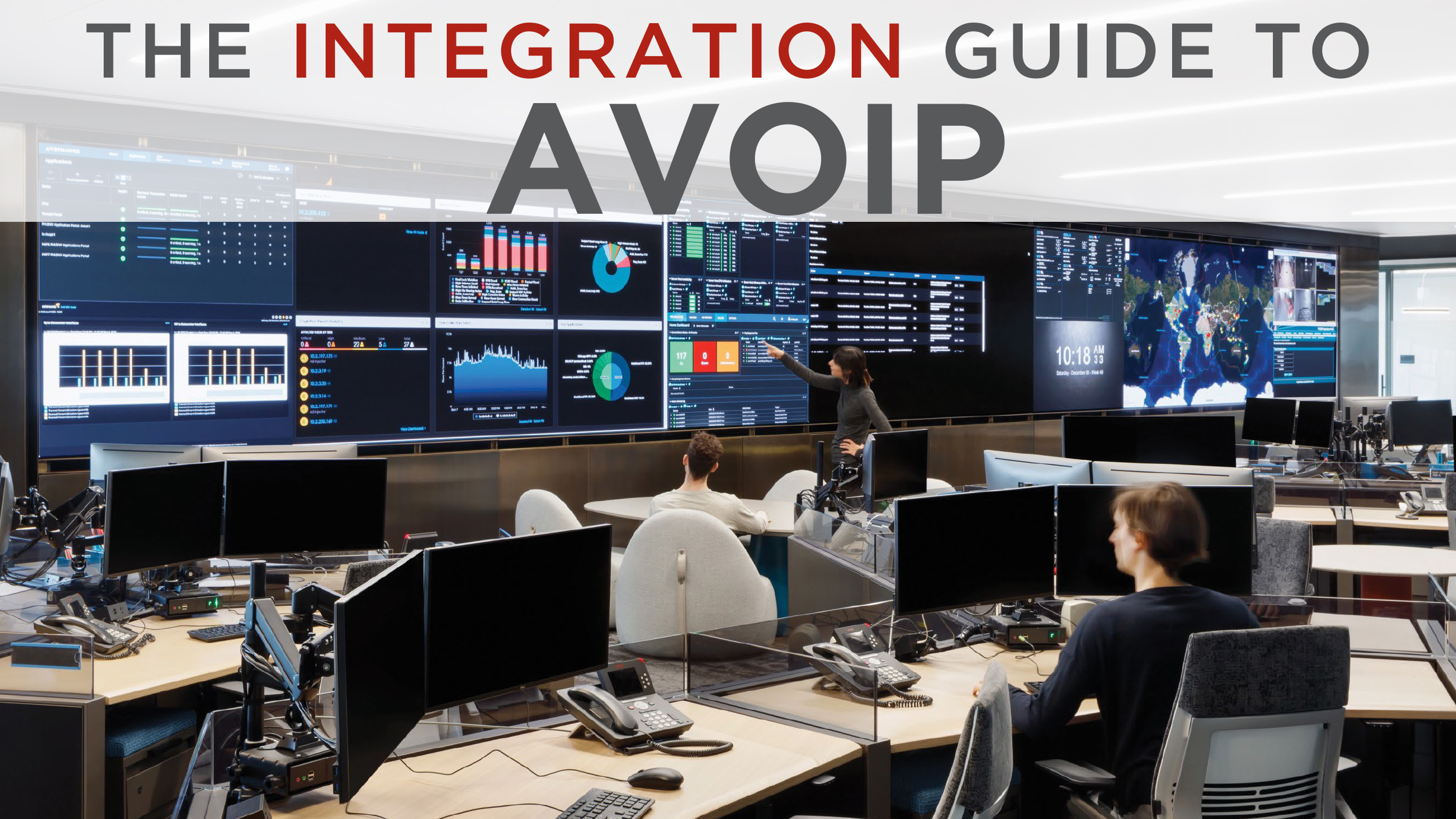
As adoption rates for AV over IP increase, the professional AV community has the chance to grow along with it.
Download your free copy of The Integration Guide to AV over IP 2020.
Arista Corp.: Paul Shu, President
The shift to AV on the network is, indeed, taking longer than many of us in the industry expected, and this is the result of several factors. Presently, there are numerous codecs—among them SDVoE, H.264/H.265, JPEG2000, TICO, and others. For the clients and their technical managers, this creates confusion and the prospect of choosing a codec that falls out of favor is enough to cause many people to take a wait-and-see approach.
Secondly, the cost of the products and their implementation can be another prohibitive factor. This leads to yet another concern that routinely arises: “How much better is a networked AV approach going to be than our present setup, and does this justify incurring the necessary expense?” Education is important in this regard, and presently, I believe that aspect of the overall sales process still requires fine tuning. As a result, the process of making the transition to networked AV has been slower than expected and we really cannot expect users to adapt faster than they are comfortable with.
Embracing IT innovations for AV applications
Ultimately, the process of merging one’s IT network with their AV network will prove beneficial—and more cost effective. Arista Corp. offers a full suite of networked AV solutions capable of addressing a wide range of projects. In due time, I believe the benefits of networked AV will become more apparent and the pace of the transition will accelerate.
ATEN Technology: YT Liang, Senior Product Manager
With AV over IP and HDBaseT, each has its own set of benefits/advantages depending on the application. To decide which is best, look at the main phases (design, installation, service) of your project and ask yourself these questions:
Design phase—which technology is best? What’s the project scale? If smaller (within eight sources/displays), a 1U video matrix can work. For 25 displays, AV over IP is better. What are your compression and latency considerations? If no compression is accepted (e.g. medical review), HDBaseT is recommended. If visually lossless compression is required (e.g. digital signage), AV over IP is better suited. How comfortable are you with network-based solutions? Are you up to date with the most relevant network knowledge (multi-case, IGMP, jumbo frames)? Ideally, go with a manufacturer that offers both types of solutions; they will have a technical team in place to provide recommendations and can assist with installation and support.
Installation phase—How can I reduce installation times? Easy configuration is key. Extender solutions with IDs and push buttons allow for switching without knowing the IP addresses. Additionally, extenders with built-in web servers allow configuration of all extenders at once.
Service phase—How to troubleshoot? With HDBaseT, it’s easier; but with AV over IP, data goes through the network switch, which means you’ll need help in showing the direction to do the troubleshooting. For example, ATEN has LED lights on our extenders that show if there’s a network, power, or HDMI issue.
AtlasIED: Gina Sansivero, VP of Marketing and Corporate Communications
The sheer number of competing protocols is having a direct impact on the networked AV market. With so many options to explore, manufacturers often play a game of “wait and see.” They wisely watch standards shake out before committing, consequently resulting in a slower than anticipated adoption rate. At AtlasIED. we base our decisions on the deployment of networked AV solutions—not on the latest buzz and technological developments, but what our dealers tell us they need to drive business. Case in point: our IP Endpoints. To our dealers, the functionality of the AV network is more important than the technology behind the signal distribution, so we focus our energy on developing and delivering products that enhance their networked AV projects with tangible end-user benefits that are simple to configure and install. While we understand the importance of protocols, our stance has been to base our decisions both on the maturity of the technology and our dealers’ input.
Atlona: David Shamir, Director of Product Management
Although adoption rates have quite accelerated to initial industry forecasts, rates have consistently increased. The speed of that adoption varies with each quarter, but there is no doubt that the AV-over-IP transition will continue.
The majority of AV consultants, system integrators, and AV/IT administrators understand the benefits of AV over IP for the pro AV market. There are several factors that have slowed AV over IP from complete “domination” when it comes to AV distribution.
In some cases, AV over IP can be overkill based on the venue’s realistic requirements. Smaller meeting rooms and huddle spaces, for example, do not require the infinite scalability and powerful feature set of AV-over-IP solutions. Instead, they require intelligent solutions that are easy to use, and move audio and video to a limited number of destinations. A smaller matrixed solution with a dedicated set of inputs and outputs will suffice in these spaces, and require a minimal investment to get the job done.
AV-over-IP installations also require IP networking knowledge. While an increasing number of systems integrators and tech managers have acquired this knowledge, the learning curve continues for the global AV industry. Many still prefer to stick with the technology they can take full advantage of today as they continue to learn everything that AV over IP offers.
Read more about how AV and IT must collaborate for successful IP network convergence.
A price comparison between circuit-based and IP systems can be significant, and that often influences integrators to develop hybrid systems that reduce overall costs. This is often a useful approach, as AV within a meeting space can be driven through circuit-based technology and switching, while AV over IP is embraced for exporting and importing content to and from external locations.
Audinate: Brad Price, Senior Product Marketing Manager
Audinate has seen consistently rapid growth of audio over IP for 14 years, and expects that trend to continue for the foreseeable future. From our perspective, much of the growth in Dante has been a direct result of design decisions that provide extensive automation and easy-to-use toolsets that allow the widest range of people to use the product effectively.
We have seen barriers to adoption of AV over IP steadily coming down and product counts increasing. But it would be fair to say that this growth has not been evenly distributed, particularly in the area of video distribution (the V in AV). Much of the reason for that lies with our moment in time: as of 2020, 1Gbps networks are ubiquitous for reasons other than AV. In contrast, networks running 10Gbps or higher that might support large amounts of video are relatively rare and relatively expensive. The requirement for video codecs is in marked contrast to the world of audio, which requires no compression and is hence agnostic to a wide range of devices and uses.
For that reason, we elected to design our new video offering (Dante AV) to work on 1Gbps networks using compression. This allows a Dante-based video system to provide excellent quality on existing networks. We anticipate that over time, networks will become inevitably faster and video codecs will be winnowed down to the most suitable for IP transport. At that point, legacy AV technologies will take their final bow.
Advantages of a 1Gb Ethernet network backbone.
Aurora Multimedia: Paul Harris, CEO, CTO
Aurora has been solving this issue two ways. First, we created a system called Simplify, a preconfigured AV-over-IP solution. The way it works is the customer sends us the spreadsheet with the encoders’ and decoders’ location labeling and IP address. They will also send a diagram of how the network switch will be connected and which units are located on which switch. From this, we will preprogram and label all the units from our factory including the network switch, as we are a platinum distributor for Netgear (which also makes us into a one-stop-shop). When the package arrives, it is all plug and play and ready to go. This in turn speeds up the installation and assures a higher probably of success. Second, we are working on hybrid solutions combining familiar technologies like HDBaseT with SDVoE, so there is more plug and play, smaller port count switches, and less IP addresses utilized. The HT Pro Series by Aurora is the start of this new age of hybrid technologies.
When it comes to AV over IP, the main issue with transition is there was no transition. With the way the systems are designed, it is a total typology change compared to what the typical AV integrator is used to. Especially when it comes to the network switch, it can require a certain level of expertise at times and can become especially complicated when there is more than one switch or multiple IP technologies that want different methods to propagate correctly through the switch.
Barco: Christopher Klepacz, Strategic Alliance Manager, Control Rooms
At first glance, the control rooms market may appear static, but the market has continued to evolve in recent years. The increase in available data sources is one example of this evolution. As is so often the case, change is the source of innovation, and the critical control rooms market is positioned to grow. Technological change, new solutions, and the experience and expertise of market leading companies are driving the change.
Technology innovations are driving change in the growth of critical control rooms. In the pro AV segment, AV over IP is experiencing significant growth with increased video quality and bandwidth. Other enablers such as the proliferation of Internet of Things (IoT) offer additional data sources from sensors and other devices, providing key insights to end users. Software solutions are improving control room operator experience by improving operations and reducing stress through intuitive, ergonomic design principles. Public and private clouds are creating new economic models for hardware deployment adding flexibility and cost savings to traditional on-premise computing environments. Artificial intelligence and advanced analytics are driving business insights and visualization technologies improve awareness and understand across the enterprise. Taken together, critical control rooms are well positioned to take advantage of these and other investments being made in organizations augmenting and improving situational awareness.
Bringing all of this together requires a partner that understands how to design and implement critical control room solutions that take advantage of the available technology. It starts with an in-depth understanding of the end customer requirements, and the knowledge and experience to deliver. This often includes having the right technology alliance to bring a “whole solution” and a robust ecosystem of channel partners to deliver. This requires advanced skill sets and a knowledge base that can be leveraged globally and delivered consistently and at scale.
Biamp: Joe Andrulis, Executive Vice President of Corporate Development
For a long time, the adoption of networked AV was slowed by the natural tendency of people to stick with familiar solutions and the learning curve faced by both AV integrators and IT departments as they transitioned AV to the network. As an industry, we’ve made a lot of progress overcoming these barriers. At this point, networked AV is a comfortable option for most deployments, but networked AV isn’t always the best approach—at least not networked AV as many of us originally envisioned.
Not all AV needs to be on the corporate network. AV that is local to single rooms or other small areas is often much easier and cheaper to design and install using traditional point-to-point connections or small matrix switchers. Sometimes even these small spaces will use networked AV, as Biamp does with its TesiraCONNECT TC-5D, which simplifies conferencing installations by providing power and media over a single category cable and connects range of AVB and Dante devices, including Tesira DSPs, USB extenders, PoE+ amplifiers, and microphones. In these instances, the TesiraCONNECT TC-5D may connect in a local AV network without connecting to the corporate network, so people may not consider it as “AV over the network”—but that’s simply a deployment choice. There’s also plenty of networked AV that looks a little different than we might have originally expected. Systems like unified communications, streaming media hosts like YouTube and Vimeo, and digital signage are all non-traditional approaches to creating AV outcomes that are all network-based. Overall, the uptake of networked AV is quite healthy and growing quickly.
Black Box: Jonathan McCune, Director of Product Management, AV and Infrastructure
The matrix switch is dead—the industry has reached a tipping point where technologies like SDVoE in our MCX platform really do kill the matrix switch. SDVoE is the only technology platform that provides all of the matrix switch capabilities, like ultra-fast switch time and 4K60 video, plus advanced video processing like scaling, video walls, and multiview.
IT administrators can configure, deploy, manage, and monitor systems enterprise wide, creating predictable performance in technology-transparent environments that are fully scalable and replicable. Unlimited number of inputs and outputs means no longer limiting the total count of connected devices. For modular solutions, MCX/SDVoE is plug and play once configured, and what’s more, all SDVoE-enabled solutions auto discover for simplified setup.
Live event providers can offer zero-latency video that is fully interoperable with projectors and sources enabled with the solution and no longer need to invest in very expensive matrix switches and additional extensions for those solutions. In applications like medical, MCX/SDVoE is the perfect solution providing both video and audio as well as USB connectivity over fiber with truly best-in-class image replication.
Bose Professional: Adam Shulman, Market Category Lead, Installed Systems
The adoption of protocols like Dante vary by the application type, the level of benefits gained from using an AV-over-IP solution (versus a more traditional infrastructure), and whether it is isolated or part of a larger network. In an audio system for a live venue, it is often on its own network. Here, adopting a protocol such as Dante is beneficial as it reduces the amount of infrastructure needed to build the system while increasing reliability as well as routing flexibility. In these situations, we see the adoption of AV-over-IP accelerating as more audio teams become familiar with various protocols and the associated benefits.
An audio system found in hotel event spaces may not be on an isolated network but instead reside on the hotel or hotel chain’s network, which is managed by the in-house IT team. Most likely the network is required to support much more than just the room’s audio system. These are the types of applications that are slower to adopt AV over IP.
Our industry needs to continue to understand the IT manager’s needs and how to play by the larger IT industry’s rules. This means we need to continue to improve how AV devices impact a network’s performance and management. We need to be less AV-centric in our thinking and demonstrate increased awareness that our products are used alongside non-AV products, and thus must obey certain conventions and rules—often where audio is not the highest priority. The term “AV over IT” may be more appropriate and demonstrate that we understand that, as an AV industry, we do not always own the infrastructure we are riding on. Improving this will improve more widespread adoption of AV-over-IP technologies and their applications.
Crestron: Alex Peras, Technology Manager, DigitalMedia
In the past, AV solution providers and IT professionals have not always communicated with each other, which has been a challenge in shifting AV on the network. Understanding the application, deciding what needs to be accomplished, and delegating roles in these projects are essential to having a successful infrastructure. Crestron encourages these conversations with IT professionals and leads the market by offering education and training that helps them understand information and anticipate their questions. Crestron has trained our dealers in AV-over-IP and DigitalMedia HDBaseT courses, while continuously providing updated materials.
Crestron recognizes that AV rooms of the past are now changing to become unified communications (UC) enabled, and AV will be the piece that ties the room together. Matrix routing technologies are now AV over IP, providing solutions that are fully flexible, scalable, and manageable. Crestron ensures all devices support out-of-the-box functionality, meet the network and security requirements of IT professionals, and work on existing Cat 5e infrastructure. Crestron XiO Cloud is driving this next wave of the transition. With all devices on the network, organizations can easily monitor and manage them. In addition, AV over IP allows organizations to tie audio, video, and USB together on the network.
As trends continue around touchless and socially distanced spaces, having a flexible and scalable infrastructure will be important in accommodating an organization’s needs. Solutions like XiO Cloud give organizations more control over their devices, allowing them to view their entire ecosystem through a single interface at any time, from anywhere.
DVIGear: Matthew Pulsipher, Product Manager
The AV-over-IP market is in a state of coalescence. From the many competing platforms, a few have begun to take leadership as they mature and proliferate. Like many new things, much of the fear regarding AV-over-IP solutions is about the risk of the unknown, especially the fear of proprietary products that are “walled gardens.” No one wants to risk being an early adopter of a platform that isn’t fully mature or is at risk of being dropped by its manufacturer a few years after purchase.
As the AV market converges with the IT world, it will benefit from the more standardized approach that has enabled new platforms to gain universal acceptance for decades. In the IT world, the proliferation of interoperable standards is what drives adoption of a new technology. USB and Ethernet are excellent examples of this: if you buy a device with USB, it is a given that it will be compatible with a standard PC, regardless of the manufacturer. Further, this standards-based approach helps ensure a clear, orderly progression of the technology over time. For example, consider how USB and Ethernet have evolved over the last 20 years.
Of the AV-over-IP platforms currently available, SDVoE is the only solution to provide a completely interoperable full-stack solution. Competing platforms are either vendor-proprietary, or fail to define the entire stack, which leads to interoperability issues down the line as vendors implement their own technologies to fill the missing layers. This isn’t to say that interoperable platforms cannot foster vendor-specific innovation. Of the SDVoE solutions available, DisplayNet is by far the most dynamic, as it deeply embraces the software-defined approach of the SDVoE platform. In the five years since it was launched, DisplayNet has added a multitude of innovative features to our platform, all while maintaining full cross-vendor interoperability.
Extron: Joe da Silva, Director of Product Marketing
AV-over-IP systems are becoming more commonplace and we continue to see lots of interest in the technology from our customers. One of the challenges to the adoption of AV over IP is education. Most solutions rely on multicast streaming, which is a somewhat specialized skillset among IT professionals. We knew that education and support would be vital to the success of AV-over-IP technology, so we created a team within Extron called the Network Technology Support Group that is staffed with network engineers who are skilled in designing, deploying, and commissioning networks. This team is focused on supporting our AV-over-IP deployments to ensure the end user has the best experience possible with Extron NAV Pro AV-over-IP products.
Another aspect that is influencing the adoption of AV-over-IP technology is the debate between 1Gb and 10Gb networks. Many end users want to leverage their existing network infrastructure. This typically means deploying on a 1Gb network that is also supporting additional business-critical services. Other end users require pristine image quality and deploy a 10Gb network to minimize or eliminate compression, but this usually means standing up a separate network infrastructure. Through the use of the patented PURE3 compression technology, Extron is uniquely positioned with our NAV Pro AV-over-IP products to have the features needed for deployment on enterprise-class networks as well as solutions to deliver pixel-perfect video on discrete 10Gb networks while delivering complete interoperability between the two architectures. We look forward to what the future holds!
Hall Research: Josh Petru, Business Development Manager, Central Region
Adoption of AV over IP has been slower than initially forecasted. One likely reason may be the learning curve for a lot of AV dealers. That being said, not every application needs a large networked solution. Take the K-12 classroom or small to medium conference room as an example: the users don’t need to switch from room to room, but just within the room’s input sources themselves. So, a dedicated video switching and extension solution may be all that they need. But even in those situations, it makes sense to control and manage the AV system over the network. At Hall Research the products that we target for small venues integrate embedded Web GUI or include GUI software for configuration and control. A nice benefit of control-over-IP is that AV managers are able to assist instructors or users from outside the classroom, if required.
Education and corporate customers are also per-room price sensitive and typical AV-over-IP systems and associated network switches are costlier than point-to-point direct implementations. In the future as the price and usability improves, that may change.
For now, the best use of AV-over-IP technology is in large digital signage installations found in hotels or other hospitality venues. AV-over-IP systems also work well in municipalities or courtrooms.
The network is the future of AV and as manufacturers start bridging the gap between the learning curve, ease of install, and system control, we expect the adoption rate for AV-over-IP within the pro AV channel to accelerate.
HDBaseT Alliance: Gabi Shriki, Senior Vice President, Audio-Video, Valens
While AV over IP marketing is in full swing, the technology has not gained much traction so far and we don’t see AV over IP getting considerable traction even over the next five years. There are several key reasons for that.
One of the biggest hurdles is the lack of a single, unified standardized technology. AV over IP is implemented differently depending on the CODEC technology (H.264, H.265, JPEG2000, VC-2, proprietary, etc.), and the actual IP network bandwidth available (100Mbps/1Gbps or 10Gbps).
AV over IP is not solving the small-scale and point-to-point use cases as well as alternative technologies such as HDBaseT in terms of cost, power consumption, video quality, latency, etc.
The wide-distribution, multiuser AV distribution is often solved using WAN-based technologies, such as cloud collaboration systems, making the need for high quality AV-over-IP solutions limited to specific use cases.
It is important to understand what the customer problem is that we are trying to solve. Different technologies bring different benefits/values—there is no single technology that solves all customer issues. Often, combining several technologies brings about the best results. HDBaseT and HDMI are and will remain the main technology used in small-scale installations, as they deliver uncompressed distribution, lower cost, and simplicity. (In fact, the trend toward smaller meeting rooms is going to further limit the deployment of AV-over-IP solutions in the corporate market.) AV over IP will be used for very large-scale networks or to interconnect between “HDBaseT rooms.”
When considering AV over IP, integrators must understand customer requirements, IP network limitations, specific use cases the customer is aiming to solve with AV over IP, etc. For example, when considering a campus-level distribution or in-between-cities distribution, an H.264/H.265 solution is suitable. It will be impossible to use SDVoE-like technology (as the requirement for 10Gbps network is impractical in this case) and even the typical 1Gbps-based AV-over-IP solution with JPEG2000 like CODEC consumes 70-80 percent of the bandwidth for one AV stream.
Just Add Power: Taft Stricklin, CEO and Founder
From our perspective, the state of AV over IP is quite strong. There are a lot of other companies in the space now, but we’ve been leading the way for 11 years. We’ve distinguished ourselves from the crowd by listening to our dealers and introducing new features and hardware based on their needs. So that puts us ahead of the curve and we’re doing things others aren’t, like adding compatibility with Dante and AES67 audio networks. We can also beat other manufacturers on price. For example, our Warp Engine isn’t the only product on the market that allows installers to rotate HDMI, but you won’t find a more cost-effective one. We’re also well known for building robust products that last for decades. So instead of constantly creating new products that will be obsolete in a year, we give new features through firmware updates. Furthermore, all models in the Just Add Power lineup integrate seamlessly with any generation of our products. What this all means is that we aren’t seeing any barriers at all to entry. Year after year, all we see is a steady uptick in the adoption of AV over IP across all markets—from retail and hospitality to entertainment complexes and airports.
Kramer: Chris Kopin, Executive Vice President of Technology
People are slow to change. At Kramer, however, we know that AV over IP has the staying power and versatility to win people over—as long as everyone is willing to participate.
When considering a transition to AV over IP, it’s not just a matter of training the person who creates the drawing; it’s the engineer, it’s the installer, it’s the end user. Controlling AV over IP from a control system is not the same as controlling the network switch as you would in a matrix environment.
As a whole-solutions manufacturer, Kramer can facilitate standard AV over IP, but it can also create a hybrid system which may employ HDBaseT in a room, and then an encoder will grab a piece of the signal and send it to another room for distance or time-delay learning. When all invested parties are on the same page, AV over IP is far from a one-size-fits-all solution, but instead a flexible and invaluable tool for keeping organizations connected in a world where we are increasingly encouraged to stay distanced.
When it comes to 1Gb and 10Gb, companies are usually in one camp or the other, but Kramer is in both. We have a couple of SDVoE installations, but 1Gb is where we are selling.
We’re a whole solutions manufacturer, so we don’t have just one piece of the puzzle. We don’t have to be just AV over IP and we don’t have to be traditional; we can be one or the other or give you a hybrid.
Matrox: Sam Recine, Vice President of Sales, Americas and Asia Pacific, AV/IT Group
When you look at HDMI, a product from vendor one works with a different product from vendor two. Perhaps there are exceptions with versioning, but, by and large, there is a published standard that multiple vendors put into products that do many different things.
Right now, the benefits of AV over IP are so strong, that already 30 percent of the market is willing to bite the bullet even if they have to stuff everything from a single vendor into their infrastructure.
Customers are tapping into longer distances, more nodes on managed infrastructure, better asset management, and new applications of converged data, live multi-party communications, and performance audio-visual content of a common media.
It is normal that organizations that can afford to hold back for more open and more interoperable stuff are going to delay while they can. Meanwhile, they are putting extreme pressure on prices for baseband stuff they know they intend to replace shortly. And they are buying their first round of AV-over-IP products for real immediate needs, not adding the next 10 years’ worth of capacity, because they know there is a fair to good chance they will see next-generation AV-over-IP products that are less invasive and far, far less proprietary.
AV over IP will see two more stages in the very near term that will add significant flexibility to end users and systems integrators: hardware and software products based on open standards that work across different brands and different product types, and a new software economy for AV-over-IP software applications that strictly focus on adding value to existing hardware from many disparate brands in the market and improve features such as setup, live operation, security, and far richer ecosystem capabilities.
Meyer Sound: Richard Bugg, Digital Products Solutions Architect Pro AV Segment Chair, Avnu Alliance
We at Meyer Sound believe that there is a significant advantage to delivering audio and control over standard network infrastructures. Audiences are expecting more from their AV experiences and while AV over IP has been possible for a long time by the technically astute, today’s industry needs to focus on delivering a solution that is easy to use, scalable, and can adapt to future needs.
Connecting computers used to require proprietary solutions from each manufacturer. This was an impediment to innovation that was removed by the development of a common network standard. It was with the realization that an open Ethernet standard for a high-quality, high-reliability, and low-latency transport protocol for moving media and control would similarly benefit everyone connecting professional AV equipment that resulted in the formation of the Avnu Alliance to promote the use of the IEEE AVB/TSN standards. Further work was done by a group of professional AV equipment manufactures within Avnu to further optimize AVB for interoperability between pro AV devices. The result was “Milan.”
Milan was created to provide a deterministic network protocol for professional quality media transport that is easy to use, future proof, scalable, and capable of delivering a convergence between audio, video, control, and non-time sensitive data on one network.
Avnu Alliance certification guarantees any certified device will interoperate with all other Milan devices. Interoperability is assured. Milan devices will work together at new levels of convenience, reliability, and functionality. The network transportation of audio and control should not be a bottleneck to innovation; it should just work.
MuxLab: Peter Justiz, Canadian Sales Manager
AV over IP was designed as a flexible, expandable, and inexpensive solution to provide data connectivity through an ethernet LAN network (1Gb version) with the use of encoders (transmitters) and decoders (receivers). However, the market has become so crowded with many AV manufacturers having families of products to complement different formats—Motion JPEG, JPEG 2000, H.264/H.265, etc. What are the right manufacturers, products, and formats to choose from?
With AV-over-IP equipment in the pro AV 1Gb space, there are limited equipment standards in that you can’t mix and match encoder, decoder, and controller products from the different manufacturers to gain maximum results. Some compatibility exists with H.264/H.265 encoders and decoders, but again, not with the controllers to manage these devices. With the SDVoE Alliance standard, the encoders and decoders designed by different manufacturers can be mixed and matched. Also, in the broadcast industry, AV-over-IP encoders and decoders follow a well-documented ST-2110 standard, which supports interoperability and other enhanced features. However, the LAN switches required for SDVoE and ST-2110 based products are 10Gb, which adds significant costs to the infrastructure. Also, PoE (power over Ethernet) ability is negated versus a 1Gb structure due to the system design.
With the current work- and learn-from-home environment, two key elements have captured the AV segment: videoconferencing and live streaming. Live streaming possesses a clear advantage in reaching more people at once. It enables you to reach hundreds, thousands, or more potential recipients quickly with just a few clicks. AV-over-IP becomes an inexpensive proposition for this. Houses of worship are now utilizing this concept to live stream services over YouTube and Facebook in lieu of social/physical distancing.
Business has now changed since March 2020. MuxLab and others in the AV segment are adapting and innovating to remain at the forefront in the new current format. AV-over-IP will be a proponent for inexpensive change and information sharing.
NewTek: Will Waters, Head of Global Product Management
When AV over IP was introduced, it was quickly seen that connecting devices more easily would enhance and expand capability and accelerate efficiency. Efficiency alone, however, cannot move an industry. Even as we promoted the benefits of infinite connections, the adoption seemed a bit slow. At least until the onset of global forces—such as a pandemic.
What is most familiar to us is always easier to continue with than wholesale change, even if the benefits are staring us in the face. The move to IP must be more than changing the type of wire. It may be that the signals flow across networks using packets instead of dedicated cabling, but many AV systems still require dedicated chipset and proprietary hardware devices to sit at the edges of networks. This slows adoption because, fundamentally, workflows and use cases are similar to what has been familiar.
At NewTek, we see this very differently. The AV world is ready for those edge devices to move to software. That software runs on commoditized hardware that is easy to maintain and not dependent on formats, frame rates, and circuits designed for a single purpose. We believe in this so strongly that we developed a free protocol called NDI to realize that future.
The next phase will see integrated software products that take advantage of bi-directional communication on a network, enhance presentations, improve communication, and expand creativity, all while being transparent. This is what is required to deliver on the promise of AV over IP.
Opticis USA: David Delgado, Senior Manager, Business Development
AV integration has taken many paths, at least for me in the last 15 years. From 78-inch-high rack stands requiring their own enclosed rooms to racks fitting in a closet drawer. From fixed to configurable card-slot matrix switchers to the favored, higher bandwidth IP switchers, and with the coined phrase in our time, we are in a “Warped Speed” transformation era.
For some customers today, the cumbersome addition of shoe-size encoders and decoders to an IP solution may not be worth the investment. If their existing AV system can be retrofitted to support 4K today, they will wait for the next rollout of 8K displays with IP systems along with sources having built-in encoders and destinations with built-in decoders.
Limitations with IP systems still exist, specifically with 10Gb bandwidth transmission. True 4K resolution at 60Hz 4:4:4 sampling rate requires at least 18Gb. The trend will be, for example, in mission-critical visualization applications such as neurosurgery with its 4K/3D microscopes, to transmit true 4K detailed clinical images. Also diagnosing cancer through remote collaboration between the surgeon and pathologist will mandate precise, accurate visualization.
Scrupulous cybersecurity protocols and standards have also softened the market growth with AV over IP when you compound wireless video transmission functionality.
Before AV over IP proliferates in the market, there are expectations for pricing to fall as well. Notwithstanding, fiber optic extenders will continue to be integrated with the AV-over-IP system, especially between source and encoder or between decoder and destination over long distances. Whether they are HDMI, DP 1.2, HD-SDI, or DVI, these video and data transmission over fiber components deliver uncompressed images with no latency, immunity to EMI, and long distances up to 100 meters.
The future is bright with lightning speed technologies like DP 2.0 at 77.4 Gbps from the fiber optic and IP world. We can also expect exciting times ahead in visualization, remote collaboration, and endless connectivity.
Renkus-Heinz: Matt Czyzewski, President
The consensus at Renkus-Heinz is that the adoption of AV over IP has been a bit slower than expected. However, that statement comes with a caveat: in the past two years, we’ve seen a substantial uptick in the number of networked products sold.
It’s our belief we have now hit the inflection point for adoption of AV over IP, where the majority of new installs are seeing AV over IP as the norm, not the exception. Thus, the growth being discussed in the space is well placed—and that is why you’ll see manufacturers ensuring they offer that full suite of networked solutions.
With that said, because we recognize the curve is still trending upward—and not at 100 percent adoption—the Renkus-Heinz roadmap is to ensure we continue to offer solutions for both types of installations—analog and networked. We will do that in a way that doesn’t require completely altering the product. Most of our new offerings in the near future will be introduced as twins—not identical, but similar enough that they provide the same ability to place sound exactly where you want it, no matter of the connection you choose to use.
What will drive adoption during the years to come will be the ability to offer easier integrations in AV-over-IP environments. That’s why we’re focusing on supporting technologies that make design, installation, setup, and support of AV-over-IP systems as frictionless as possible. And when we make life easier for the integrator, the results are improved for everyone in the AV world!
RGB Spectrum: Andy Thompson, Vice President Marketing
AV-over-IP market adoption initially ramped up slowly, but is now accelerating as infrastructure, education, and product ease of use catch up with traditional baseband video.
While AV over IP brings many benefits, it requires new expertise in IP networking for integrators and site administrators, and a willingness to build out networks to support these products. AV over IP is ideal for new sites or expanding video distribution capabilities across the enterprise. It’s harder to sell into sites that already have baseband infrastructure or aren’t growing. For administrators and users, AV-over-IP systems are becoming easier to use, as limited control interfaces are replaced by drag-and-drop GUIs that provide flexible content distribution, remote monitoring, user access controls, and much more.
RGB Spectrum’s Zio AV-over-IP platform builds on our 30-plus years of experience to deliver an enterprise-level solution, using open standards to efficiently deliver video over gigabit LANs, global WANs, and mobile devices. It includes an extensive array of AV-over-IP devices including encoders, decoders, multiviewers, and video wall processors. Zio supports H.264/265 signals from third-party IP cameras and other sources distributed across the enterprise. An intuitive browser-based user interface features live video thumbnails and drag-and-drop simplicity, with no software installation. A smartphone app supports content distribution to a mobile workforce.
Establishing new workflows enabled by AV over IP requires more than just technology. Education and changes to operations take time. As governments and enterprises shift to distributed workflows, AV over IP will grow increasingly important. With these activities firmly underway, enterprise AV-over-IP adoption is picking up speed and will continue.
SAVI Controls: John Dorsey, CEO
Today, more than ever, businesses rely on audio-video experiences to communicate, sell, market, entertain, educate, train, and support their customers and differentiate their customer experience. As more of the economy reopens and offices, campuses, entertainment venues and other businesses rebuild, companies must rethink their AV/IT needs.
Traditionally, the pro AV industry has been challenged with complex networking and a lack of device compatibility, as well as an overabundance of cords, boxes, and connectors to bring the entire experience together—offering installers a fragmented ecosystem that increases install complexity and cost, and can take weeks or months to program. In a post-COVID world, functionality such as displays, control, security, and signage are drastically changing and must get less expensive, simpler to program, and easier to use. It is even more critical that the integrator community has access to solutions that reduce the time and expenses spent on a project, particularly as customer needs shift as businesses rebuild. AV systems, especially control, must be designed around the network, rather than shackled to antiquated technology platforms. At SAVI, this is top of mind for us. We’re hard at work getting ready to unveil something that will disrupt this old-school cycle to streamline and simplify AV/IT control in an installation.
SDVoE Alliance: Justin Kennington, President
It’s true—we are not yet living in an “all-IP world.” I admit that I myself have even been caught by surprise that the tipping point hasn’t quite arrived. Or has it? You never quite know until you have the benefit of hindsight. I’ve come to realize that the holdup is, ironically, the IT department. You see, the AV industry has forever been a place where standards don’t exist—where manufacturers building walled gardens is the norm. This is definitely not how the IT department likes to do business. Can you imagine trying to sell Dell laptops to an IT director, and explaining that he will have to throw out his fleet of HP laptops, because emails won’t work between Dell and HP? Of course not! It’s a ridiculous thought, and yet it’s how AV sales work every day. Is it any wonder that we aren’t succeeding when the IT department drives purchasing decisions?
The SDVoE Alliance is attacking this problem at its source, by offering the only interoperable standard for AV over IP. Today the Alliance comprises more than 50 member companies shipping over 200 products, all of which are full interoperable with one another, to deliver matrix-switch performance over off-the-shelf, low-cost Ethernet networks.
Sennheiser: Kai Tossing, Head of Product Management, Business Communication
We have seen the rise of AV-over-IP solutions over time. There were times when the amount of AV-over-IP technologies and incompatibilities rather confused customers to choose the “right” one. Now, the situation is much clearer. In the area of higher education or corporate, we see Dante and AES67 being the de facto standards offered in all current products.
But AV over IP is just one aspect of modern system design; it is also about remote monitoring and control of devices. A networked device is available anywhere on the network providing audio signal, data insights, and remote control.
The pace of adopting the benefits of AV over IP is dependent on pain of installation and maintenance, budget, and skillset. The bigger the installation, the larger the pain installing and maintaining hundreds of devices and their connectivity; hence, the more it makes sense to have connected devices that you can centrally monitor and control. In small installations there may not be a need for interconnectivity and central management, so classic analog AV may still be fine or good enough.
We see new installations going straight into digital networked designs embracing AV over IP. Retrofit projects and projects limited in budget still can benefit from analog connections. That’s why the latest Sennheiser solutions like TeamConnect Ceiling 2, our most advanced dynamic beamforming ceiling microphone, and SpeechLine Digital Wireless, our dedicated-to-speech wireless microphone family, come with all options: dual-Dante connectivity, AES67, and support of latest IT standards such as IEEE802.1x, but also analog connections for seamless integration and to support every system design.
Shure: Chris Lyons, Senior Manager, Integrated Systems Global Marketing
AV-over-IP is a growing trend in the industry and Shure continues to evolve with the needs of the market. In fact, Shure just globally launched IntelliMix Room—the first audio processing software for Windows 10 PCs that is fully optimized for use with Shure networked system microphones.
Shure’s customers seem ready to embrace the benefits of networked AV: reduced costs, easier deployment, and remote management. In smaller rooms especially, a networked microphone and software-based DSP minimizes the footprint required, making premium AV conferencing a practical alternative to a basic speakerphone or soundbar.
The transition to AV networking isn’t being driven by one type of product as much as by the fact that all of the different pieces of the audio ecosystem are now talking to each other. It is much faster to configure a new installation (with software like Shure Designer) and to “copy and paste” that setup to additional rooms. Networked audio components also can be checked and managed remotely (with SystemOn software).
The audio ecosystem approach allows systems integrators to install more rooms more easily, more consistently, and more cost-effectively than traditional solutions. And it’s not just for small rooms; with up to 16 channels of comprehensive audio processing, IntelliMix Room can handle applications like training rooms and lecture halls.
The move to AV over IP is gaining traction quickly because the benefits are attractive for both the integrator and the AV/IT manager. Shure is prepared to make this transition as effortless as possible.
Vaddio: Paul Cords, Director of Product Management and Sales
We’ve all heard the term “analog sunset,” or the gradual obsolescence of analog high-definition devices. But remember that that sun didn’t set overnight! In many ways, the adoption of AV over IP is following a similar arc. Adoption is slowed by many factors, including the alphabet soup of proprietary formats like NDI, Dante, AVB, and our EasyIP along with standards like SMPTE 2110, SDVoE, PoE, Telnet, and H.264. It doesn’t all quite “just work” as one big happy family of interchangeable devices.
Surely there are compelling reasons to make the leap to AV over IP. The ease and speed of installing systems that use a single Cat-6 cable is convenient. Flexibility in design, for example, in multi-purpose or combine-divide rooms, can be a big advantage. And let’s not forget the ability to use existing infrastructure for transport.
Vaddio continues to embrace the shift to AV over IP with our EasyIP professional AV ecosystem and Dante-enabled products. We are helping customers reap the benefits of this “AV-over-IP sunrise” by investing in educational materials on networking best practices and teaching sessions on configuring our Luxul network switches. It is no longer just about the AV endpoints like cameras and microphones, it is about setting up networked systems that pass the IT department’s security requirements. The reality is that we no longer live in our known pro AV bubble, but rather are equipping our dealers and integrators with tools to successfully win opportunities in the IT world’s domain (pun intended).
WolfVision: Michael Lisi, National Distribution Manager
To create an IP video matrix, installers simply connect Cynap-powered workstations to a local area network and then use an intuitive drag-and-drop interface to create a visual floorplan of the meeting space. Within minutes, users can begin routing signals between workstations simply by connecting the dots on the newly created digital floorplan. Multi-day implementations are now taking only hours and projects are being completed for a small fraction of what they once cost.
Our experience is that the commercial AV industry is embracing and swiftly adopting networking technology as a standard part of system design. However, it could be that some integrators are reluctant to deploy network-based solutions, perhaps because they aren’t confident in their ability to set up, configure, and manage IT networks, or they haven’t invested the time to learn the intricacies of a certain vendor’s solution. vSolution Matrix is unique in that it doesn’t require network expertise or custom programming to set up and configure. This makes it easy for integrators to use vSolution Matrix to leverage IP-based video distribution and compete successfully on larger projects.
When considering cost and ease of installation, WolfVision’s vSolution Matrix solution is a game changer because it eliminates the need to purchase and install matrix switchers, signal extenders, encoders, and decoders. It also uses standard, cost-effective network infrastructure to operate and eliminates the need for custom programming and third-party control systems. All of this makes it surprisingly simple to set up and manage. The end-user experience provided also hails a dramatic change for the industry by forsaking traditional control panel design to deliver an intuitive new drag-and-drop control experience that works on any browser-enabled device or touchscreen.
Yamaha Unified Communications: Holger Stoltze, Senior Director of Technical Sales and Marketing
Yamaha’s products have successfully supported AV-over-IP for years. We have observed strong use cases in events and corporate settings. Event usage is driven by the need to simplify complicated setups and reduce the time spent setting up equipment. Simple setup is also a prevalent requirement in corporate environments. However, the adoption of AV over IP in that vertical has been held back by the limited availability of components that support AV over IP, integrate easily, and are priced reasonably. This is now changing.
We will see greater adoption of corporate AV-over-IP implementations with the development of easy-to-install, fully integrated solutions. These plug-and-play solutions rely on IP networking instead of AV-specific wiring, which allows IT departments to help in the installation and management of AV solutions. AV over IP is a necessary prerequisite for this step.
For the time being, these AV-over-IP solutions will remain standalone for two reasons: One, closed solutions remain easier and faster to implement because they don’t necessitate an AV design that fits them into a complete system. Second, IT departments at this time do not allow sources creating an unknown amount of highly rated QoS data onto their network until they clearly understand and have proof of the impact that each device has on other services.
As Yamaha moves ahead, all integrated audio devices under development will support AV over IP.
ZeeVee: Bob Michaels, CEO
There are several factors holding AV over IP back from wider implementation, particularly in the U.S. For one, there is still a need for greater levels of education on this technology on the part of both integrators and end users. Integrators that are unable to provide factual answers—particularly to knowledgeable and experienced IT professionals confronted with a proposed AV-over-IP system—may face fierce resistance to putting AV on a customer’s network. In addition, integrators who have not approached networked AV with an open mind to see the obvious benefits may decide the traditional matrix system model is not broken, so why fix it?
We are big boosters of supporting the channel through education. We have started a dual-tracking webinar series with SIGNAL Sessions that explore best practices for AV distribution in key market segments (such as enterprise, higher education, hospitality, etc.) and Certified Solution Partner Trainings that dig deep into SDVoE and AV over IP and award participants with AVIXA CTS credits. In addition, we are a founding member of the SDVoE Alliance and support the organization’s SDVoE Academy, its training and education programs.
We believe that once the benefits are better understood, the prospect of transitioning from traditional matrix systems to networked AV will be normally aspired to, rather than feared.
Zigen: Ed Dellalyan, President & Lead Engineer
The industry has been slow to move to the SDVoE 10Gb network while it has adapted to installing the 1Gb AV-over-IP solutions quite well. There are several reasons for this. The main reason is lack of understanding about bandwidth requirements, compression, and their effects on installations. The industry has done a great job marketing 4K solutions and content, but has failed to educate about what is necessary to pass through true 4K60 4:4:4 content from source to display.
Traditional 1Gb solutions add roughly 64:1 compression, and that makes high-bandwidth 4K60 4:4:4 content look like 4K30 4:2:0 at best. This compression creates artifacts, granularity, and limits feature sets like HDR. Therefore, when an integrator mistakenly thinks 1Gb solutions have enough bandwidth to pass through true 4K60 4:4:4 content and that the content that is passed through is “good enough,” why would they push their clients to the more expensive 10Gb solutions? We haven’t done our job as an industry to educate about the feature sets of 10Gb (SDVoE) solutions. 10Gb solutions have the bandwidth for true 4K, instant switching, virtually zero latency, tiling, and flexibility to grow the ecosystem over time, and won’t be antiquated anytime soon. The higher cost is balanced out as updating and adding on to the system in the future will cost significantly less than having to install an entire new ecosystem.
The latest AV-over-IP products
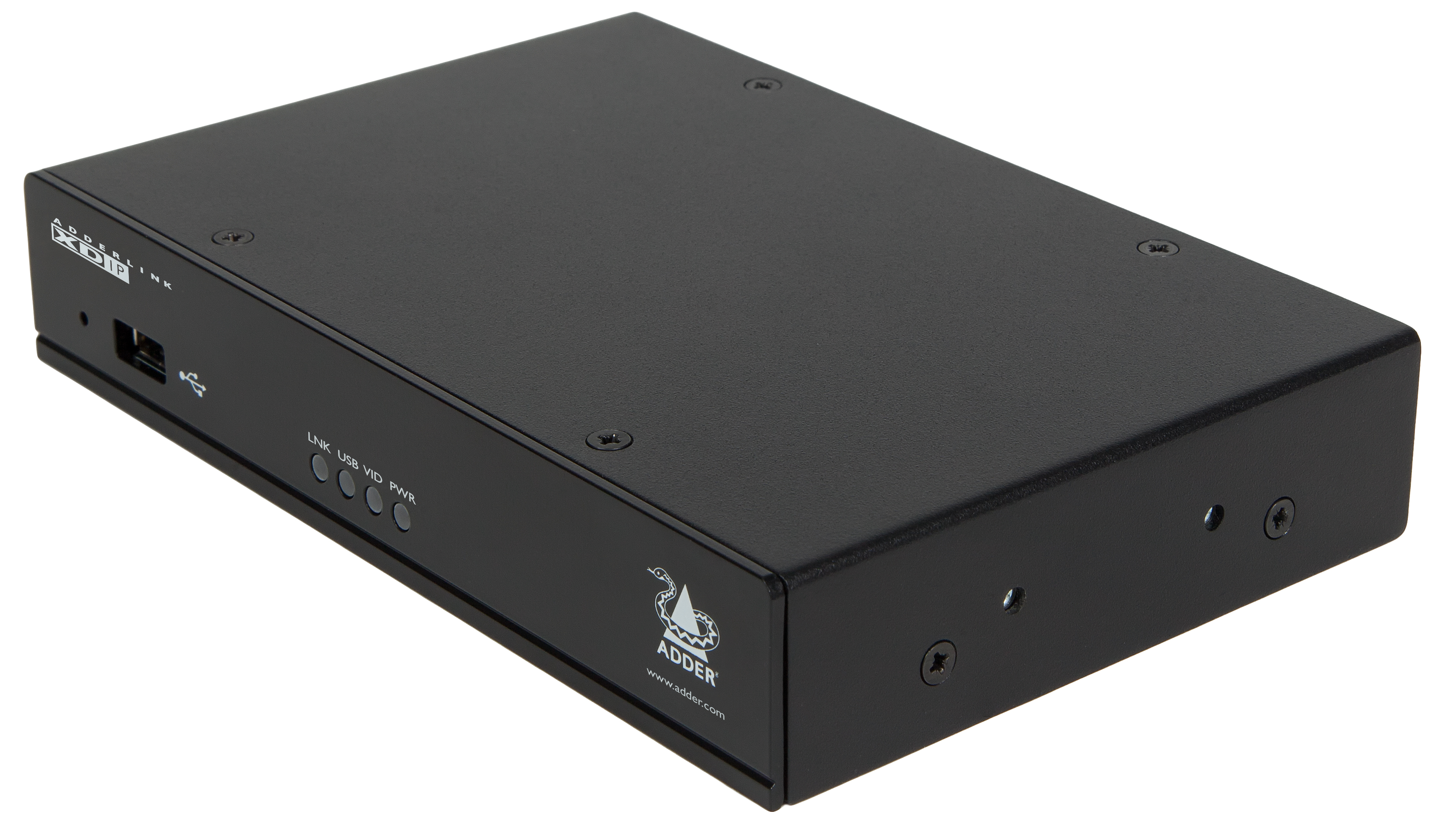
Adder ADDERLink XDIP
Well suited for small to medium businesses looking to remotely manage and multicast critical computers or a video distribution network, the ADDERLink XDIP is a high-performance IP KVM matrix and point-to-point extender designed to bridge the gap between KVM and AVoIP. The XDIP delivers the advantages of enterprise-grade IP KVM without the unnecessary complexity and cost. Recent enhancements to the XDIP platform comprise of an expansion for the receiver to access 16 sources and the transmitter to broadcast to 256 receivers, the introduction of secure remote control via a RESTful API or web browser, and support for power over Ethernet (PoE) in the United States.
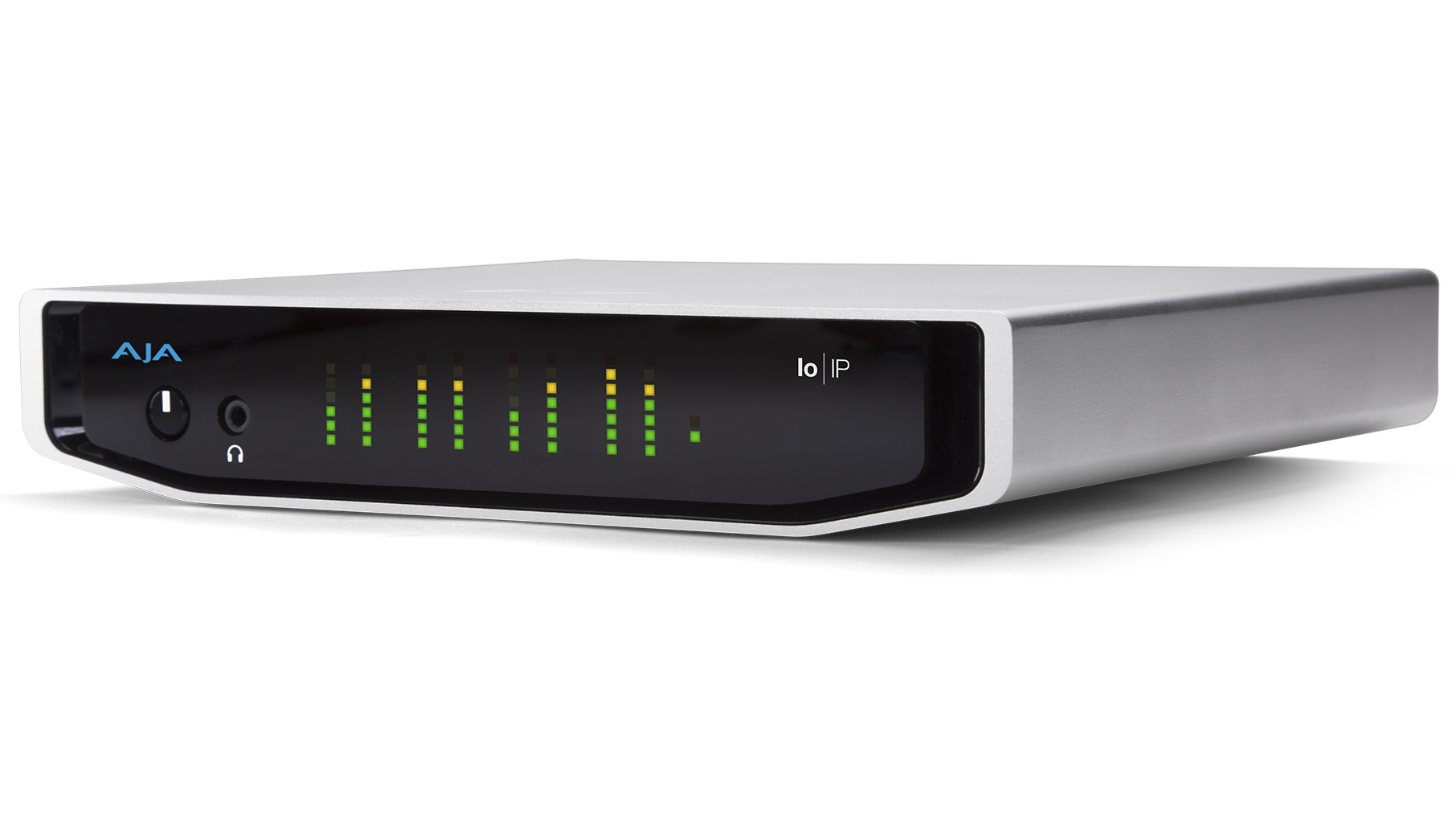
AJA Io IP
Transition to AV-over-IP with the AJA Io IP, a portable Thunderbolt 3-enabled ingest and playback device for professional video and audio over IP. Io IP supports HD and UltraHD SMPTE ST 2110 and SMPTE 2022-6/7 uncompressed video IP standards with redundant signal reliability, enabling users to bridge 10 GigE to the most popular NLE, and live production software applications. Io IP offers flexible monitoring, allowing users to edit, playback, and deliver remotely from virtually anywhere within a network. Flexible architecture ensures that as IP protocols advance, workflows are future-proofed for compatibility with the latest IP standards via firmware updates.

Arista RS-124-31 Series
With six models—the RS-124-A31-TX01, RS-124-A31-TX02, RS-124-A31-RX01, RS-124-B31-TX01, RS-124-B31-TX02, and RS-124-B31-RX01—Arista’s IP Flash Caster family changes the dynamics of the pro AV industry by letting installers and system integrators replace proprietary AV matrix switches with off-the-shelf Ethernet switches that deliver higher performance, flexibility, and scalability. Arista’s RS-124 Series is a 1U rack-mount AV-over-IP product that can be configured with either dual SDVoE encoders/decoders with copper or fiber interface and a variety of different video signal format inputs and outputs. The IP Flash Caster RS-124 Series provides numerous configurations and functionalities to meet changing pro AV requirements.

AtlasIED IPX
The IPX networked mass communications platform expands existing VoIP or SIP communications systems by enabling the integration of IP endpoints, such as speakers, paging stations, and digital displays. Adding these devices to the IPX network improves the effectiveness and coverage of messaging for routine, daily use and emergency situations.
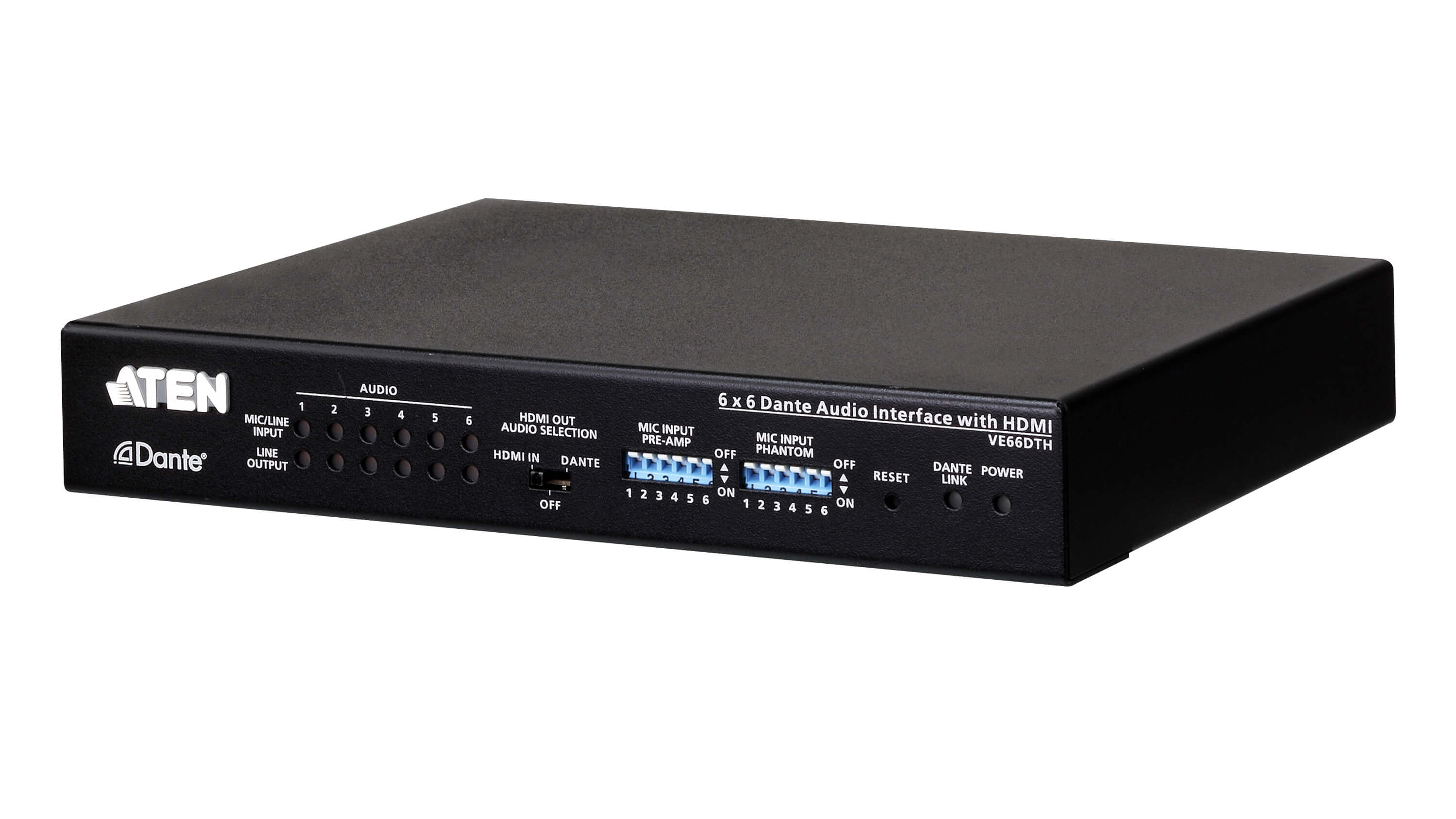
ATEN VE66DTH
Delivering uncompressed, close-to-zero-latency digital audio signals across a standard IP network, ATEN’s VE66DTH is a Dante-enabled six-input/six-output audio interface with HDMI. Audio inputs can support line input and dynamic and condenser microphones. With built-in PoE, the VE66DTH can be powered through Ethernet cable. It provides flexible audio capabilities with de-embedding and embedding and can de-embed and embed audio signals to HDMI. The VE66DTH is tailor-made for a wide range of environments that require implantation of Dante-based professional audio devices for extended and flexible networked AV applications.

NewTek TriCaster Mini 4K
The TriCaster Mini 4K is a complete, compact live multicamera video production system that comes with features like Live Story Creator and LivePanel, designed to make the production of network-quality shows even easier for lone producers or small teams—whether they are beginners or seasoned video professionals. By utilizing the free-to-use NDI network protocol, the ability to send AV signals over standard 1Gb networks empowers creators to turn any spare room or office—or, perhaps, living room, garage, or basement—into a professional studio reflecting the identity or brand of any business, house of worship, school, or agency.

Atlona AT-OMNI-112
Atlona’s AT-OMNI-112 (OmniStream 112) is a single-channel networked encoder within the OmniStream Pro AV over IP family. OmniStream 112 processes two channels of encoding in a single, half-width rack enclosure, offering cost-efficient, high-density integration. Operational benefits include enterprise-level/campus-wide scalability, built-in security and network error resilience, and broadcast-quality 4K performance with visually lossless compression. OmniStream 112 also maximizes uptime with automatic failover and recovery when deployed in redundant configurations, and in alignment with IT systems and best practices.

Zigen IP-Logic
IP-Logic is Zigen’s premier AV-over-IP product to extend, distribute, and convert 4K video in a scalable platform for deploying an almost unlimited number of HDMI sources and displays. Utilizing 10GBase-T networks, IP-Logic will stream any HDMI source to any display with no compression (or visually lossless 1:4 compression of 4K60 4:4:4/4:2:2 HDR) and virtually zero latency. The Encoder and Decoder units come equipped with autonomous EDID management and independent scalers to allow seamless video distribution in mixed-display environments. Employing the latest SDVoE and AES67 standards, IP-Logic is well suited for commercial, residential, broadcast, military, and government applications.

Black Box MCX
The new Black Box MCX multimedia distribution and management system takes advantage of SDVoE and modern 10GbE infrastructure to allow AV and data payloads to exist on the same IT networks. Through advanced chipset technology, common control APIs, and interoperability, SDVoE technology ensures zero latency and uncompromised video while offering significant cost savings along with enhanced system flexibility and scalability. While enabling truly converged network AV, Black Box MCX ensures almost zero latency, instantaneous switching, bandwidth efficiency, and high-quality video and audio. MCX simplifies and accelerates the process of consolidating AV and data on a single network, enabling organizations in virtually any industry to reduce network management time and costs, as well as total cost of ownership. Users can take advantage of the software-defined solution to deliver better-quality audio and video, which can translate to greater customer satisfaction and faster time to revenue.

Biamp Tesira
Tesira is the world’s only integrated, networked audio and video processing and distribution platform, according to the company. Sophisticated, adaptive DSP is the core of what Biamp does and what Tesira delivers. Tesira SERVER and SERVER-IO are configurable I/O DSPs, while TesiraFORTÉ devices are fixed I/O DSPs available in different models optimized for specific applications. Rounding out Tesira DSPs are the TesiraLUX video encoders and decoders. All Tesira products can be configured and managed using Tesira software, helping to create dynamic, efficient AV systems.
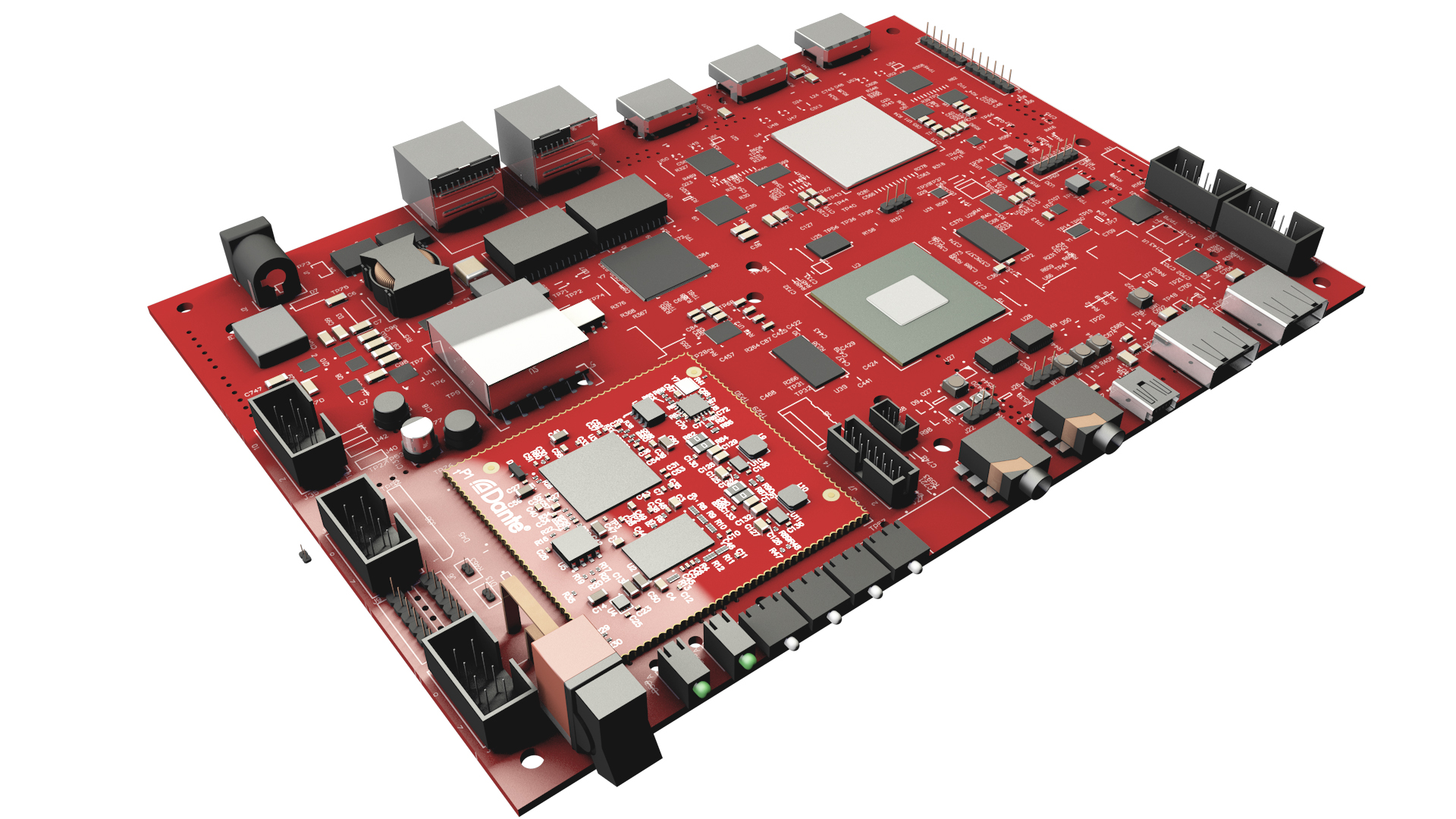
Audinate Dante AV
Dante AV is a solution for manufacturers that allows any 1Gb codec to be used to send and receive video and eight channels of Dante audio over a standard network. It employs the same well-known control software and tools as Dante audio. Dante AV consists of a hardware module that handles networking aspects of a product, while the included Dante AV Product Design Suite provides a complete hardware and software design for implementation of Rx and Tx products using the included JPEG2000 codec, optimized for low latency and high fidelity. Dante AV allows manufacturers to jump into the AV-over-IP space with confidence in performance and user acceptance.
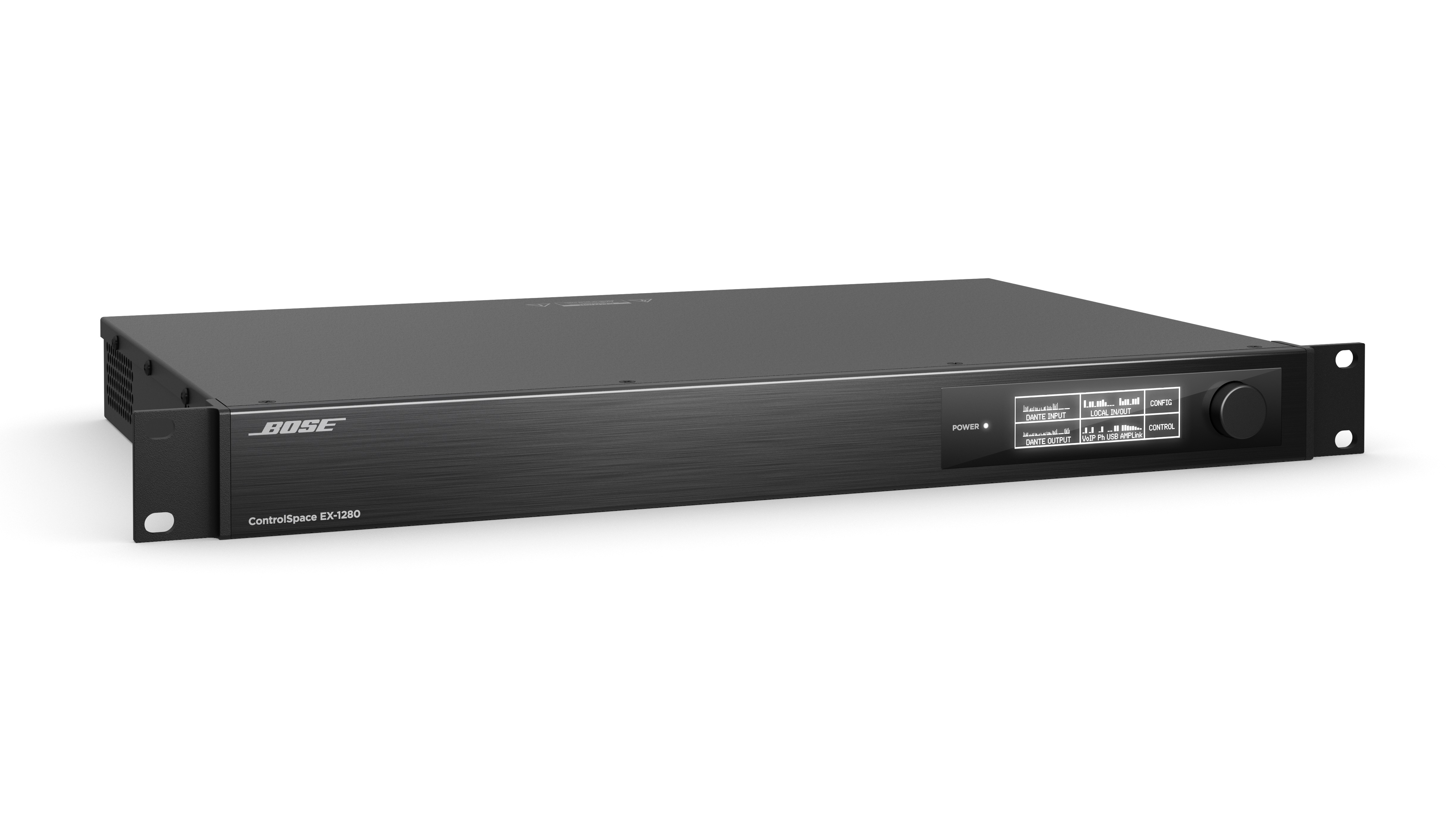
Bose ControlSpace EX
Bose ControlSpace EX is a family of digital signal processors with an open-architecture, single-rack-unit design with analog I/O, Bose AmpLink outputs (for use with Bose amplifiers), and up to 64x64 channels of Dante I/O. ControlSpace Designer software simplifies the setup process with drag-and-drop programming. ControlSpace EX has the features to support installed systems of various sizes and the flexibility to meet future needs, and with new Dante Domain Manager compatibility it increases the IT team’s ability to manage Dante-enabled devices. The EX-1280C, EX-12AEC, and EX-40C variants are also available for conferencing applications, adding acoustic echo cancellers (AEC), VoIP, and PSTN support.

ClearOne VIEW Pro
VIEW Pro is a professional multimedia streaming solution for existing IP networks, with ultra-high-quality 4:4:4 (4K30) and 4:2:0 color space, and 24 bits per pixel. The system supports high resolution—4K SKUs support up to 4K60 DCI (Digital Cinema Initiatives) and 4K60 UHDTV (Ultra High Definition TV). It is a highly efficient codec with lossless compression and ultra-low bandwidth, and has low glass-to-glass latency for 1080p streams, typically below 60ms. VIEW Pro supports RTSP/UDP standard transport protocols for compatibility with third-party products such as cameras, PCs, and more.
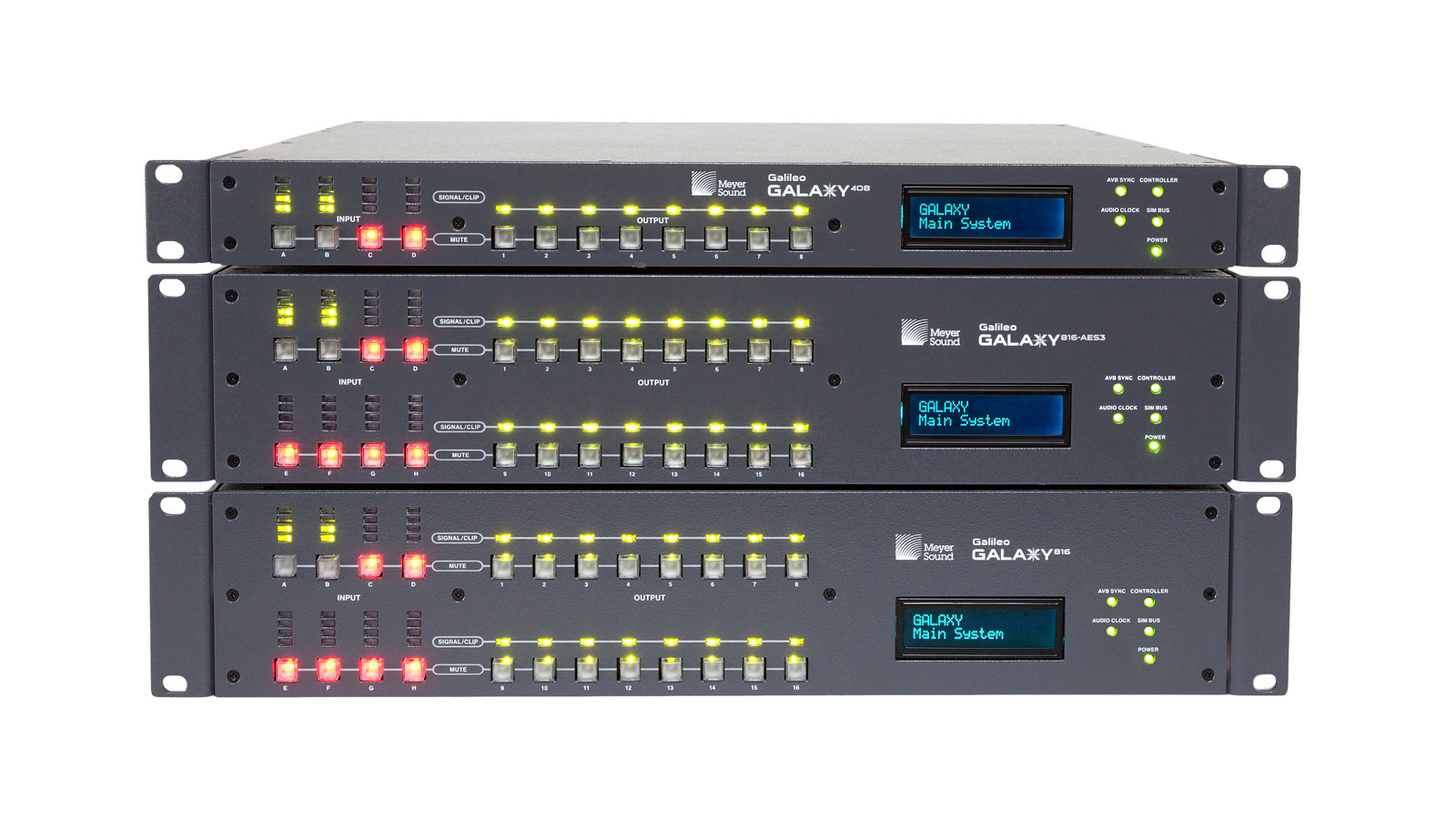
Meyer Sound Galileo GALAXY
Among the first products to receive Milan certification is Meyer Sound’s Galileo GALAXY Network Platform, including GALAXY 816, GALAXY 816-AES3, and GALAXY 408. Milan certification ensures that Galileo GALAXY processors will offer seamless interoperability with all other Milan-certified devices in the signal chain, regardless of function or manufacturer. GALAXY can connect to other GALAXY processors and can also serve as a master FOH processor by connecting to third-party, Milan-certified array processors or processor-amplifiers, either directly or through a certified network bridge. GALAXY also can connect via Milan to a certified mixing console without the need for its own network switch.
HDBaseT Spec 3.0
HDBaseT Spec 3.0 is the only solution that enables uncompressed, long-distance distribution of HDMI 2.0 (4K60 4:4:4), for superior quality and zero latency, according to Valens, creators of the technology standard. Valens’ Stello family of chipsets is the basis of Spec 3.0, including integrated on-chip features and HDBaseT port duality, enabling the same chipset configuration as either transmitter or receiver for significant cost reduction. It also enables convergence of several native interfaces over the same HDBaseT link, simplifying installations, and guaranteeing interoperability and full backward compatibility with previous HDBaseT specs.

d&b audiotechnik Milan DS20
The DS20 is d&b audiotechnik’s first product offering for connecting its loudspeaker systems to the open-standards-based Milan protocol. The Milan is a deterministic network that inherits all the technical benefits of Audio Video Bridging (AVB) technology: improved reliability, optimum synchronization, and hassle-free network setup. Integrating seamlessly as part of a d&b system, the DS20 Audio network bridge interfaces between Milan networks and AES3 digital audio signals, while also providing distribution of Ethernet control data.
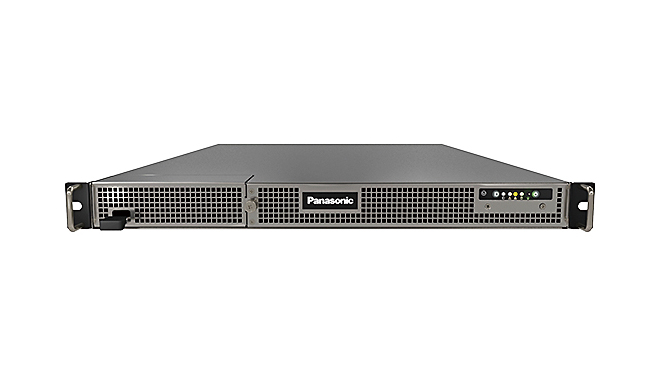
Panasonic KAIROS
KAIROS, Panasonic’s new IT/IP video processing platform, offers an open architecture system for live video switching with maximum CPU/GPU processor utilization for virtually unlimited ME scalability, resolution, and format independence.As a native IP, ST 2110 system, KAIROS supports transitions to live, uncompressed IP workflows and can eliminate the constraints of dedicated hardware. KAIROS creates new production opportunities involving a mosaic of IT ecosystems with a variety of COTS components from vendors in multiple industries.
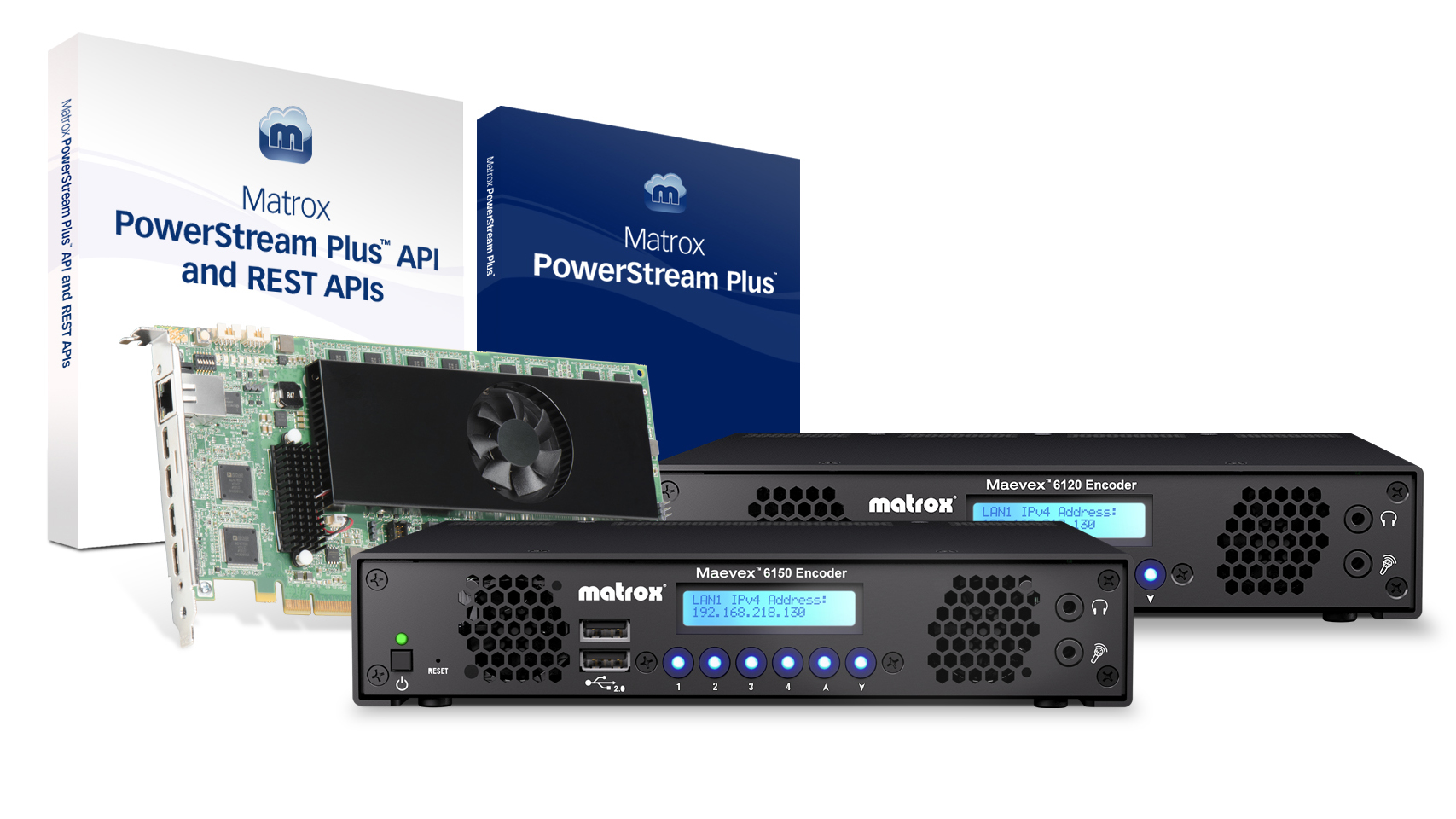
Matrox Maevex
The Matrox Maevex family of encoders and decoders deliver AV infrastructure over IP capabilities that balance security, latency optimization, features, quality, open standards, and bitrate management for low invasiveness on existing capacity. When using Maevex encoders to Maevex decoders, the included Maevex PowerStream Plus software provides an out-of-the-box experience. But Matrox believes that AV-over-IP products need to be good citizens on networks of interoperable products. This is why, in addition to the supplied software, Matrox provides different APIs and developer tools to allow for integration with third-party hardware and software. This interoperability is not limited to the command and signal management. Even the high-performance content payloads can work with third-party products. For even deeper developers, Matrox also provides tools to personalize user experiences and create workflows that best serve customers.
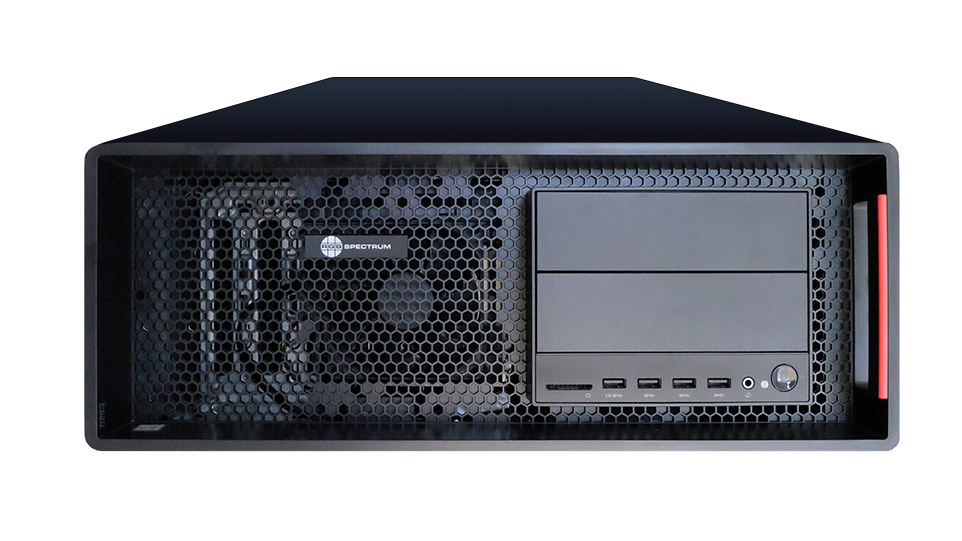
RGB Spectrum W4000
The W4000 video wall processor is the latest addition to RGB Spectrum’s Zio AV-over-IP platform, a suite of hardware and software products optimized for enterprise-class video distribution. Enterprise AV-over-IP accelerates collaboration by sharing information-rich visual displays across the enterprise and between organizations. Zio distributes video from baseband and IP sources across LANs, WANs, and to mobile devices. Integration with Zio enables the W4000 and other video sources across the enterprise to be managed through a browser-based interface. The W4000 is the first full-function video wall processor fully integrated with an enterprise class AV-over-IP platform.
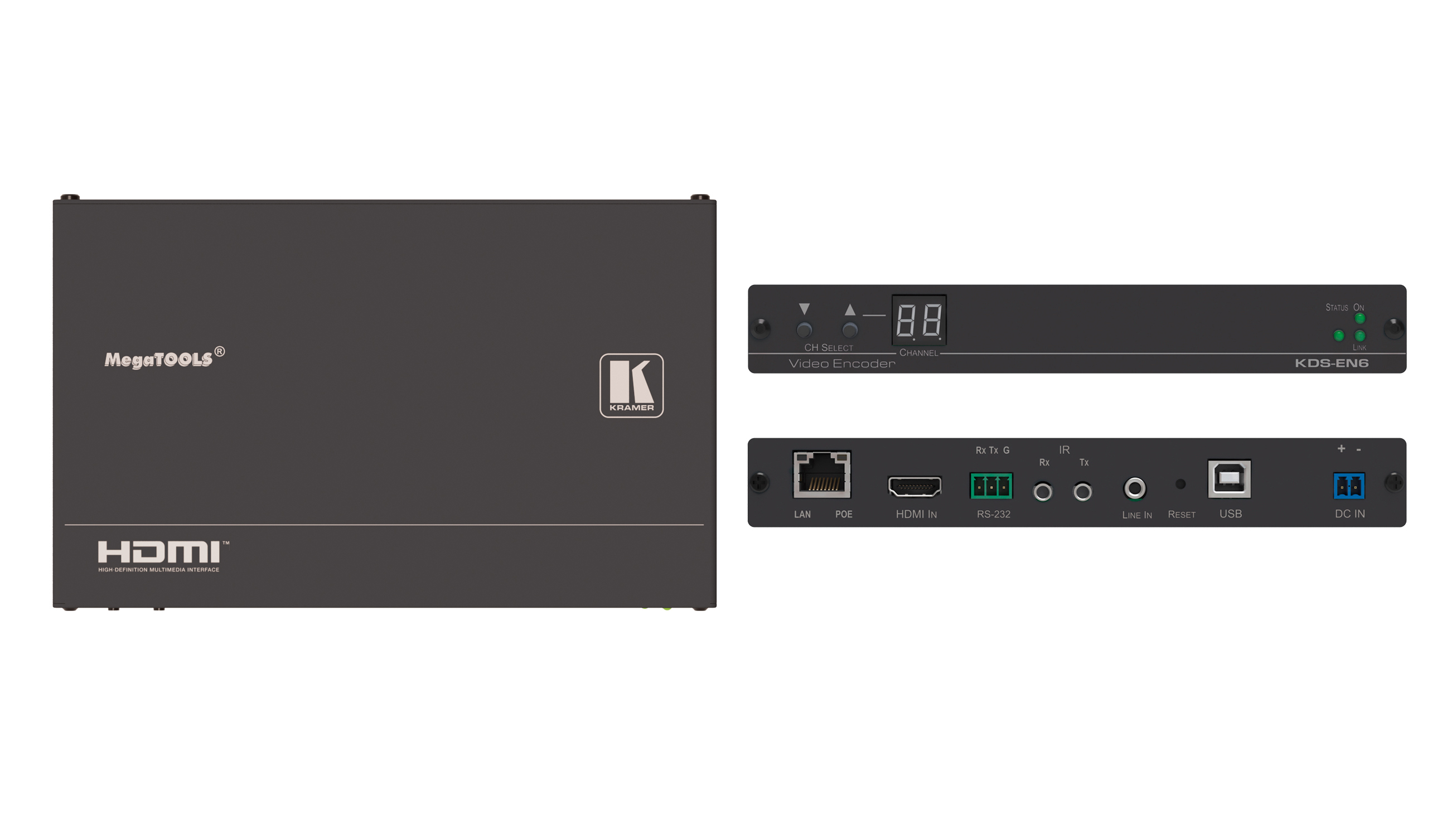
Kramer KDS-6 Series
Part of the Kramer AV-over-IP family of solutions, the Kramer KDS-6 Series are scalable, cost-effective, end-to-end AV-over-IP solutions designed for IT. Users can build any size AV distribution system on their existing IP network with Kramer KDS-6 encoders and decoders (including built-in scaling and control signaling with RS-232, IR, and USB), and manage it all from Kramer Network, Kramer’s enterprise management platform. Regardless of latency, resolution, or compression requirements, the Kramer AV-over-IP lineup of devices pairs value and versatility with uncompromising quality.

Opticis IPVDS-700-ED
The Opticis IPVDS-700-ED is a 4K HDMI IP Video Wall Control solution for playing multiple sources of audio-video on a video wall and other displays simultaneously. It also splits a high-quality video into multiple videos and plays it on the video wall and other displays. IPVDS-700-ED provides the optimal solution for large video wall systems in control rooms, security, and traffic control; it can be also be used in general fields like conference, education, or presentation rooms. The PC program can be used for host allocation and previewing, equipped with drag-and-drop operation with simple mouse use. Users can easily merge, split, overlay, and clear for host allocation.
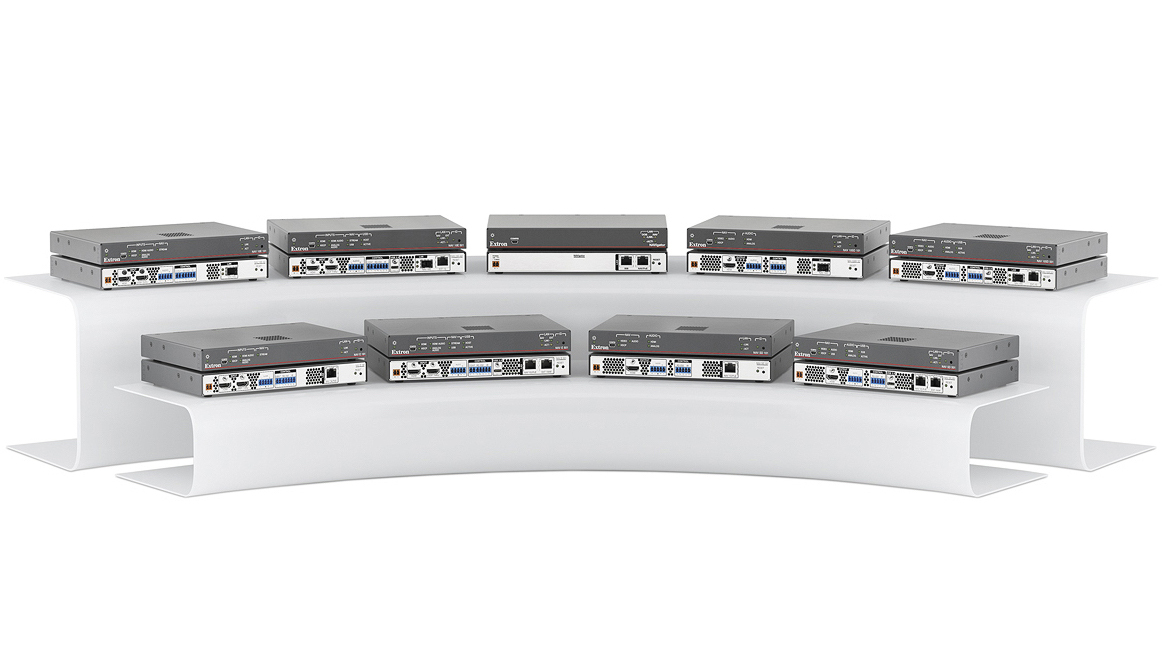
Extron NAV
NAV is an AV-over-IP solution for distribution and switching of ultra-low latency, high-quality video, audio, and USB 2.0 signals over an Ethernet network at low bitrates. Utilizing Extron’s patented PURE3 codec, it delivers high performance with real-time, lossless video over IP at resolutions up to 4K60 with 4:4:4 chroma sampling and ultra-low latency. The NAV Series can be deployed as an IP-based video and audio matrix, combining the flexibility of an IP-based system with the integration-friendly video and audio switching features found in conventional Extron matrix switchers.
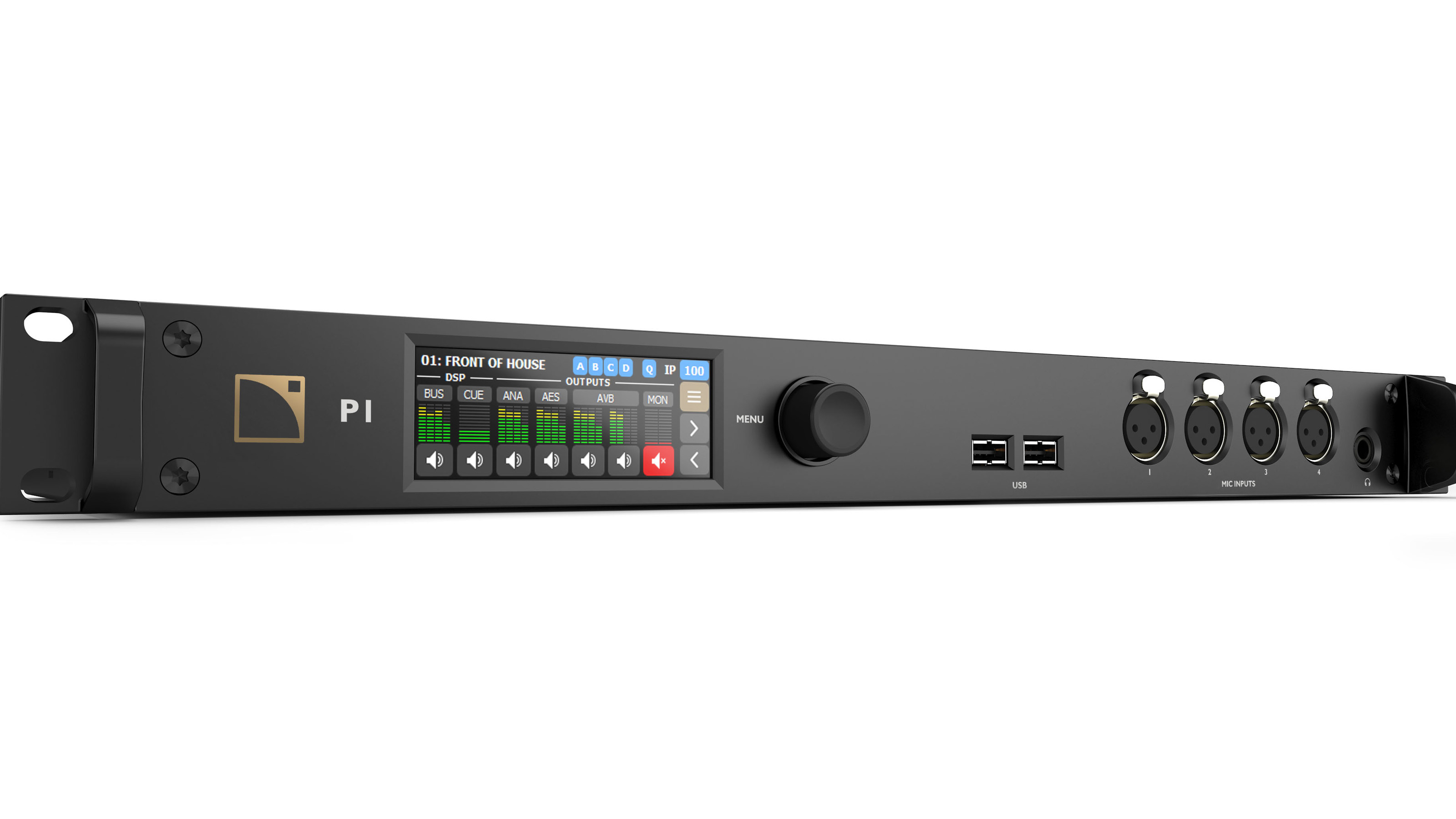
L-Acoustics P1
The multifunctional P1 AVB processor and measurement platform has established itself as an indispensable tool for many audio pros. Designed from the very start to be compliant with Avnu Alliance’s new Milan interoperability protocol, P1 became one of the very first two products on the market to officially receive Milan certification through Avnu Alliance as a fully compliant Milan device earlier this year, according to the company.
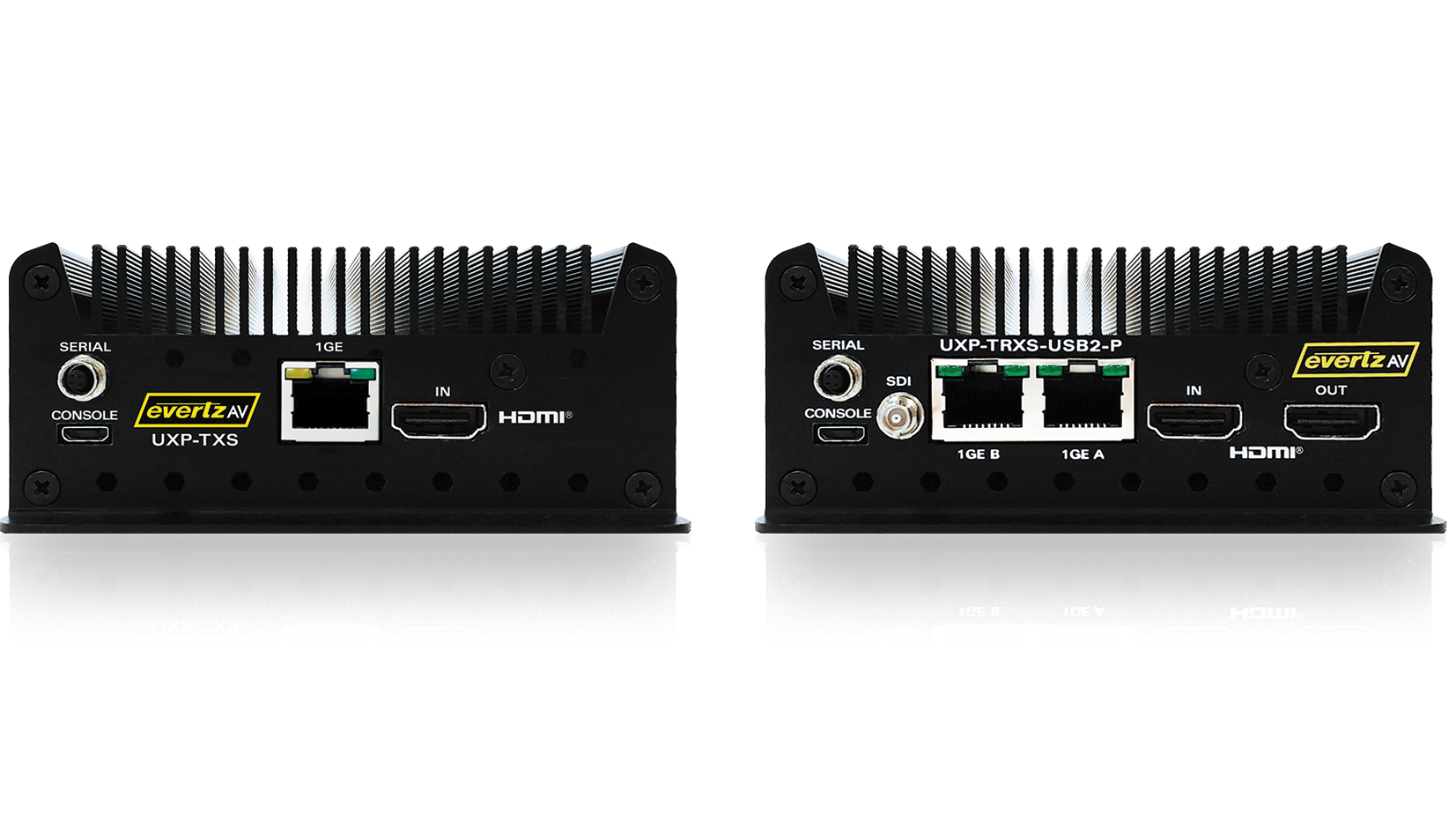
EvertzAV NUCLEUS Platform
EvertzAV recently introduced three new additions to the NUCLEUS platform. The UXP-TRXS-USB2-P is a transceiver with video (HDMI/SDI), audio, serial, USB HID, and USB 2.0 capabilities. The UXP-TXS transmitters and UXP-RXS receivers are cost-effective, single-channel HDMI gateways with serial functionality. In addition to being compact and quiet standalone devices that can be remotely powered using PoE+, all three gateways support resolutions up to 4K and can be deployed on 1GbE and 2.5GbE networks.

Hall Research POLARIS-1
The Hall Research POLARIS-1 is an IP controller with internal web servers to support up to 32 users simultaneously. Designed for GUI control of large AV-over-IP installations, it enables administrators to create various zones or rooms and assign displays to each zone. Display names and video source names are programmable. Layouts or maps can also be uploaded to aid users in identifying the physical position of the displays in each zone. Each specific user can be assigned the zones that they are allowed to view and control. Users can access the controller using any browser from any smart device.
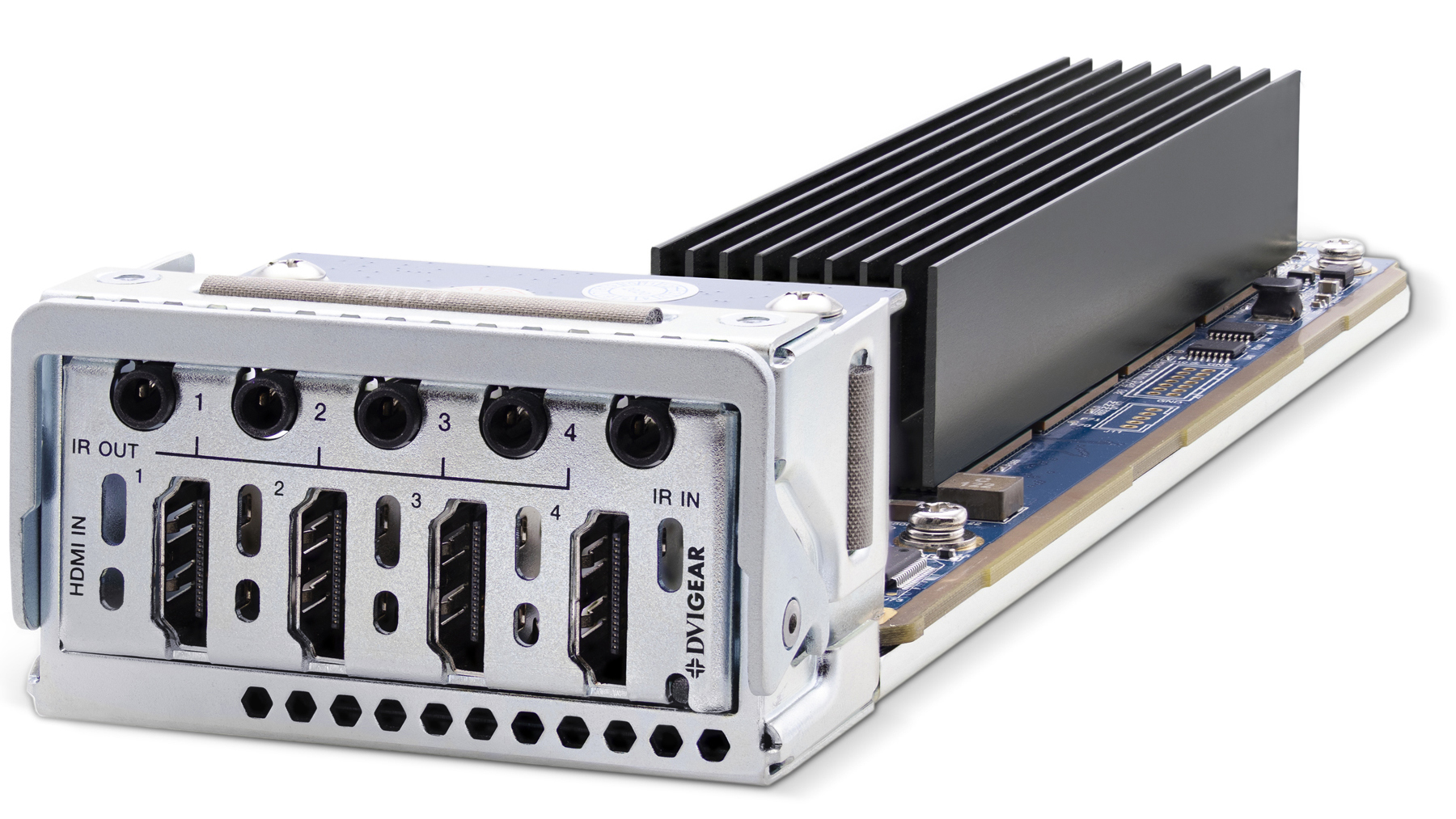
DVIGear DisplayNet DN-150-TX-Quad
The DisplayNet DN-150-TX-Quad is an HDMI SDVoE Input module for the Netgear M4300-96X network switch. Compatible with all SDVoE systems, this module adds four HDMI input ports to the Netgear M4300-96X network switch, enabling lossless, zero-frame-latency matrix switching for 8-bit 4K60 signals with 4:4:4 color sampling. The DN-150-TX-Quad delivers excellent value, and is equivalent to four standalone DN-150-TX units, at half of the cost per port, and with significantly higher physical density. DisplayNet Manager SDVoE Controller software enables easy access to advanced SDVoE features, with a web-based user interface and transparent access to the DisplayNet API.
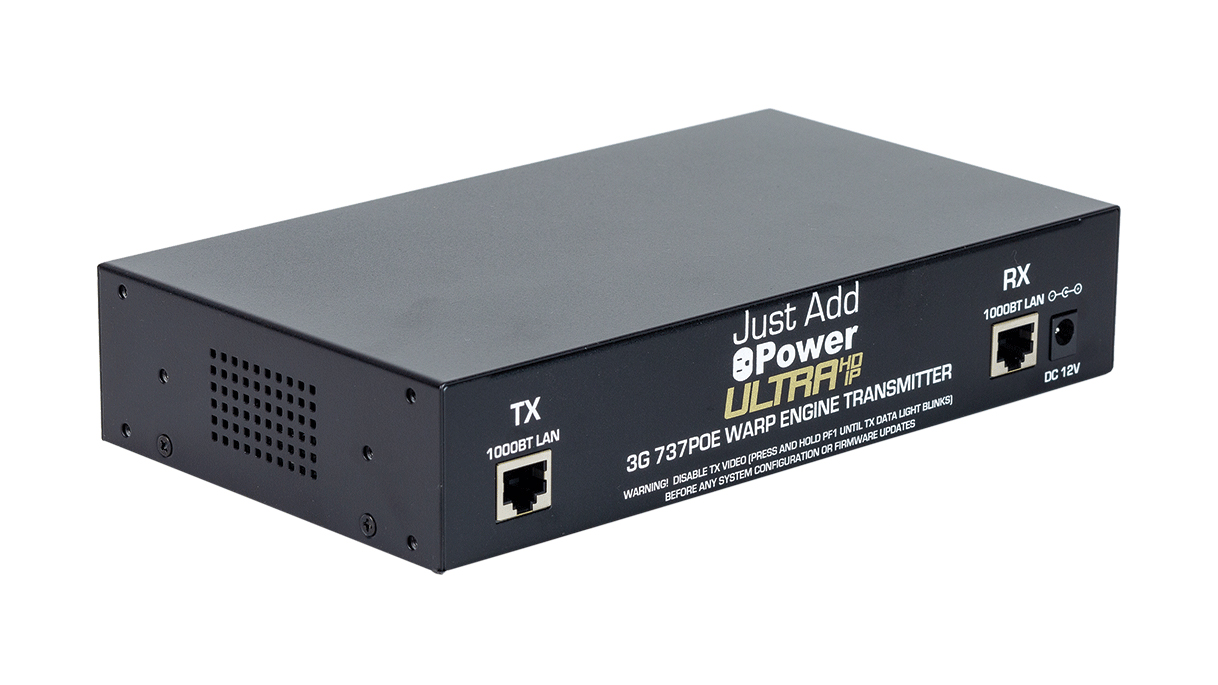
Just Add Power Warp Engine
Just Add Power’s Warp Engine is a 1RU transmitter/receiver that allows installers to easily deploy video walls with eye-catching designs featuring mixed-and-matched display models mounted at any angle. With the Warp Engine, installers can rotate any HDMI source—cable boxes, media players, game systems, cameras, and more—in a Just Add Power matrix in 0.1-degree increments in real time to achieve incredibly low latency. The rotated image can then be sent to an unlimited number of receivers in the network, allowing for the creation of massive artistic video walls using a single Warp Engine.

Vaddio EasyIP
Vaddio’s EasyIP Ecosystem includes AV-over-IP solutions that are designed to be easy to use, easy to install, and provide industry-leading video quality. EasyIP products send audio and video over IP, eliminating the need for more expensive video switchers, controllers, and extension systems. Joining the EasyIP Ecosystem in summer 2020 are the all-new EasyIP Mixer and EasyIP CeilingMIC D.
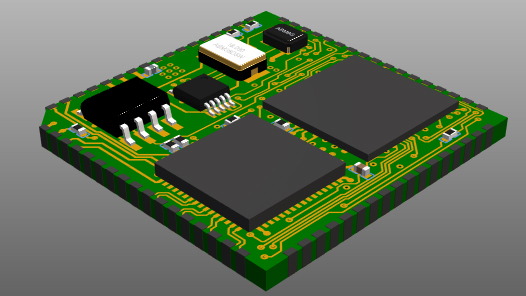
Neutrik Milan
As an open standard and collaborative effort, Milan is continuously evolving, and members are focused on finding new ways to make the protocol an even better solution for end users. A Milan Module certification program was recently developed, for example, and made available for manufacturers that wish to implement a Milan-certified module into their device and submit for certification, without having to go through the full certification testing. This will help speed the adoption and growth of certified product availability.

SAVI Controls SAVI 3
Coming in August, SAVI will debut its next-generation system, SAVI 3. Built with deep commercial AV expertise, SAVI 3 streamlines installation, programming, and expense with simple programming tools, intuitive end-user software to manage the system on site, and a whole new line of hardware. To unveil this system, SAVI will host SAVI.Connect on August 26, a virtual event that will showcase demonstrations and online booth tours for a hands-on, immersive look at the cutting-edge SAVI 3 system.
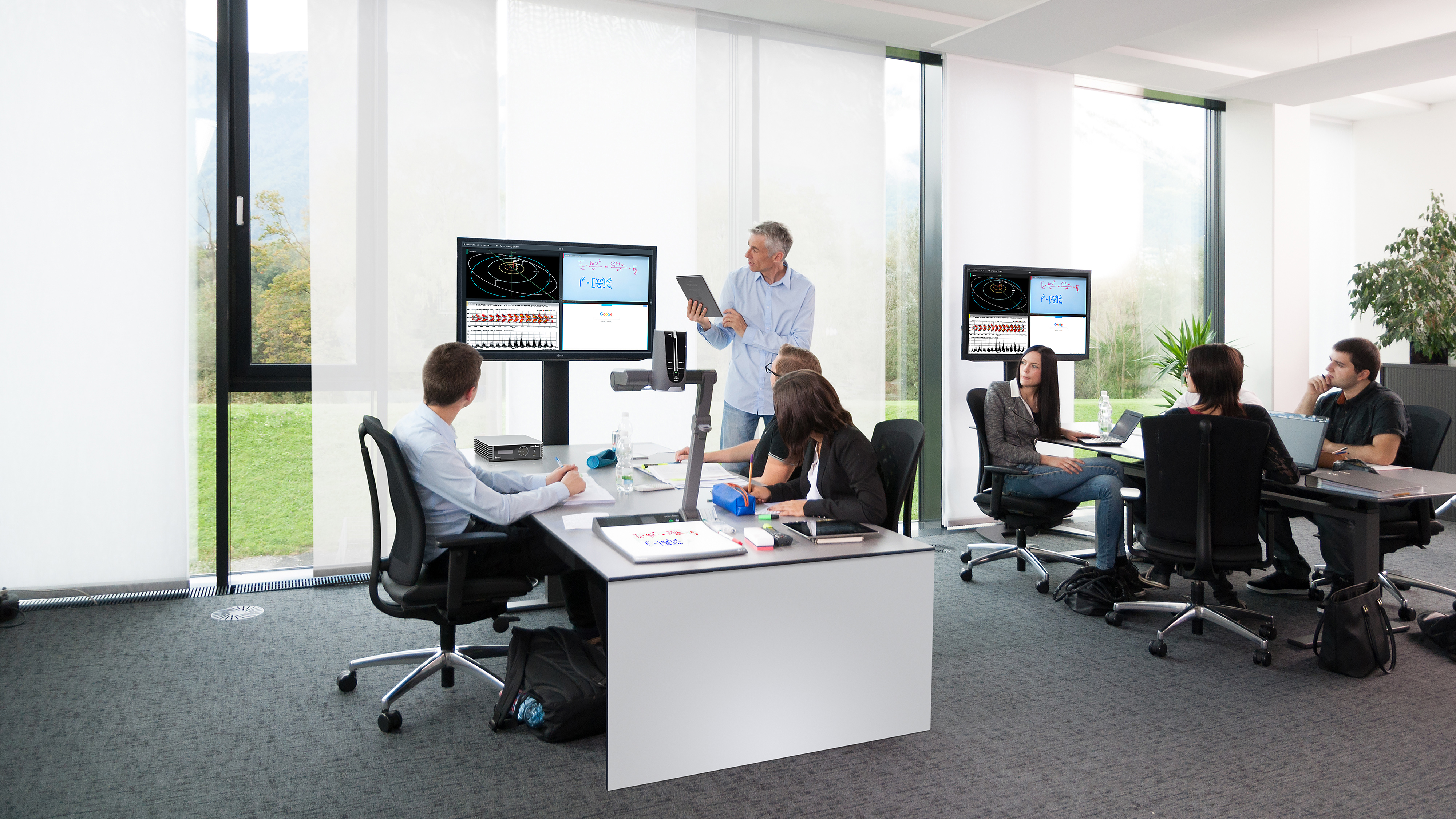
WolfVision vSolution MATRIX
vSolution Matrix is a unique AV-over-IP solution for active learning classrooms, meeting spaces, and courtrooms that is designed to be cost effective, easy to install, intuitive, and enjoyable to use. Multiple WolfVision Cynap and Cynap Core presentation and collaboration appliances can be deployed to stream video and audio between screens, using a unique and highly intuitive drag-and-drop interface that makes controlling multiscreen working and learning environments with up to 40 individual workstations easier than ever before.

ZeeVee ZyPer
The ZeeVee ZyPer product families provide a market-proven solution for the distribution and management of AV over IP, including support for uncompressed 4K, UHD, and 1080p in a variety of form factors and input types. Evolved from decades of experience in video encoding and IP networking, ZyPer enables AV and IT integrators to rapidly deploy AV solutions of unlimited scale, unsurpassed performance, and unrivaled reliability over industry-standard IP networks. A robust feature set includes built-in support for video walls, multiview, zones, signal transport over cable or fiber, and a network management platform that speeds and simplifies system setup and expansion.
